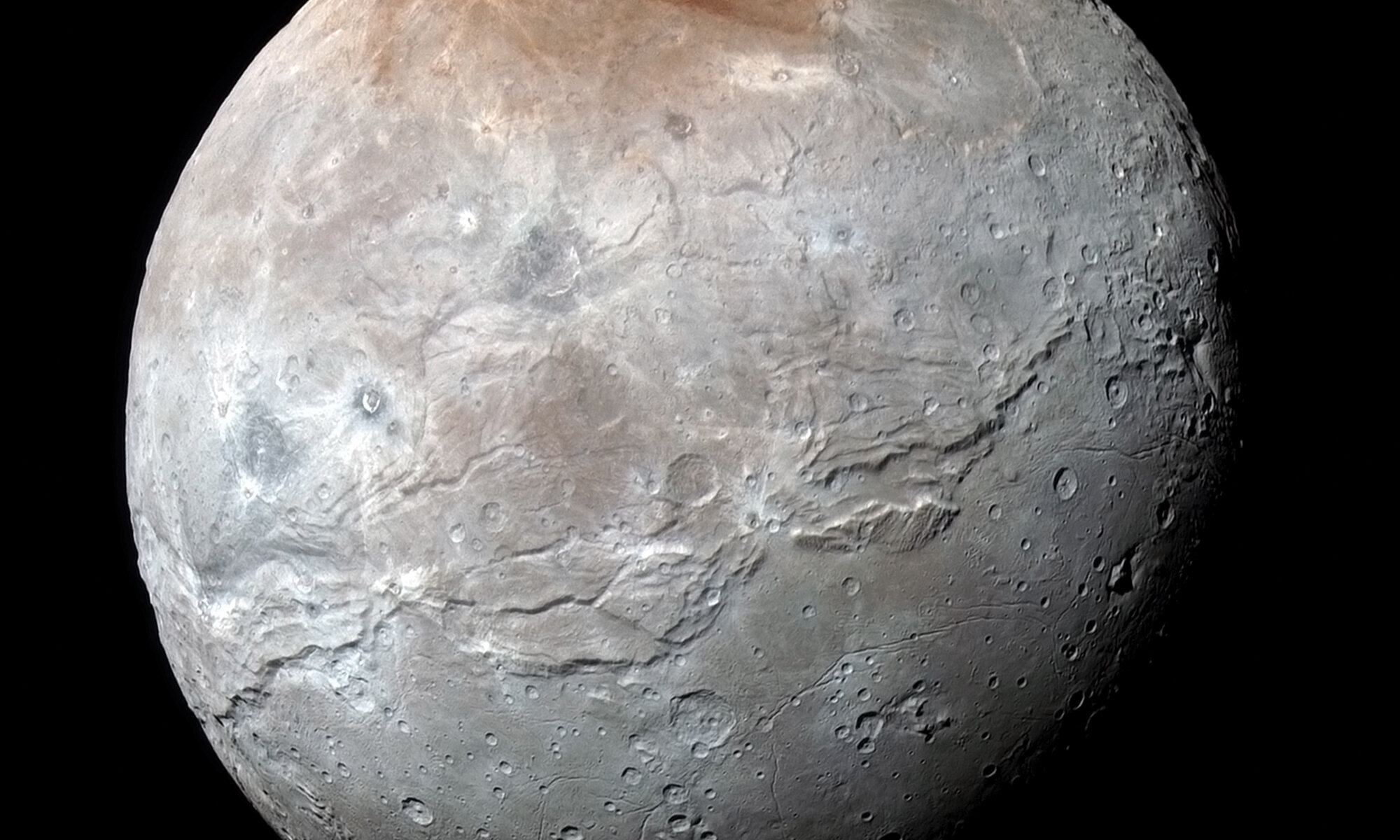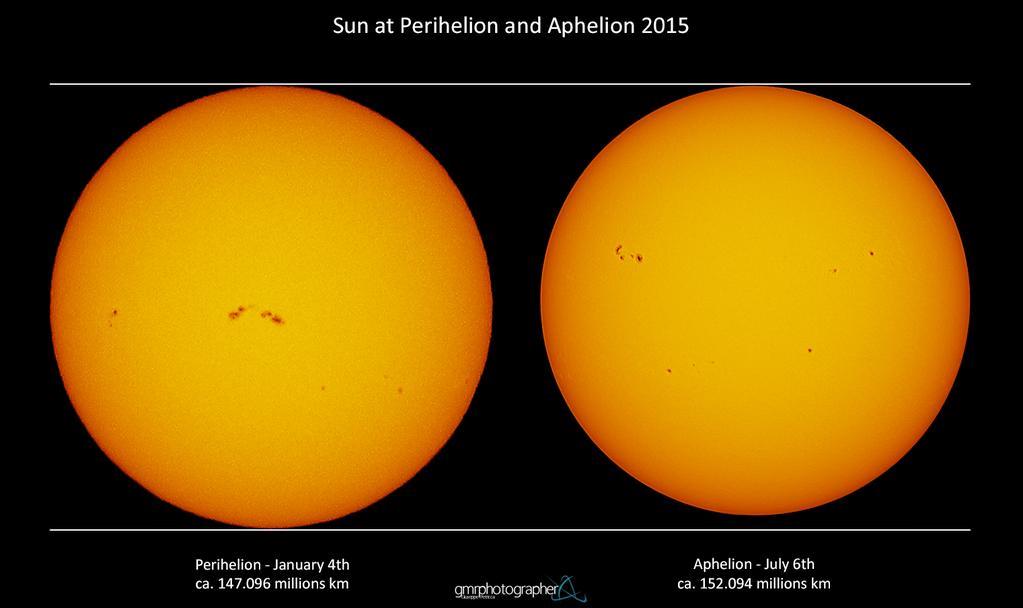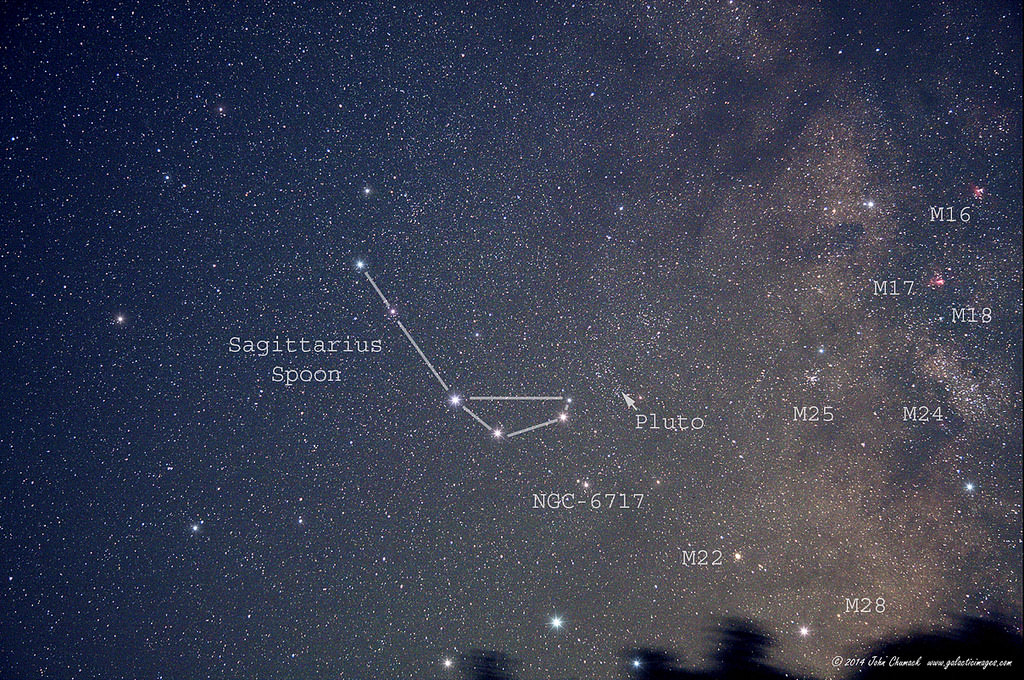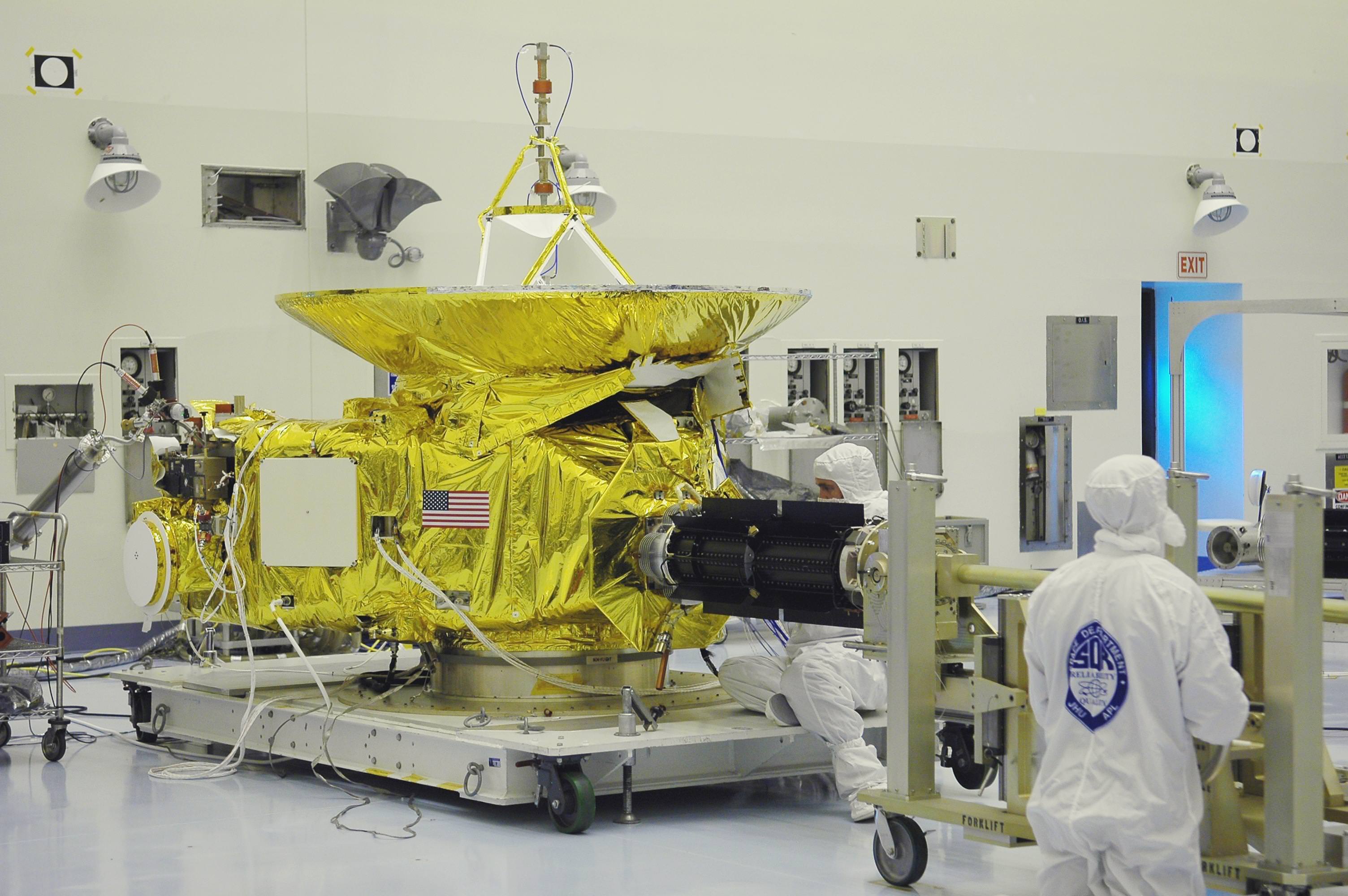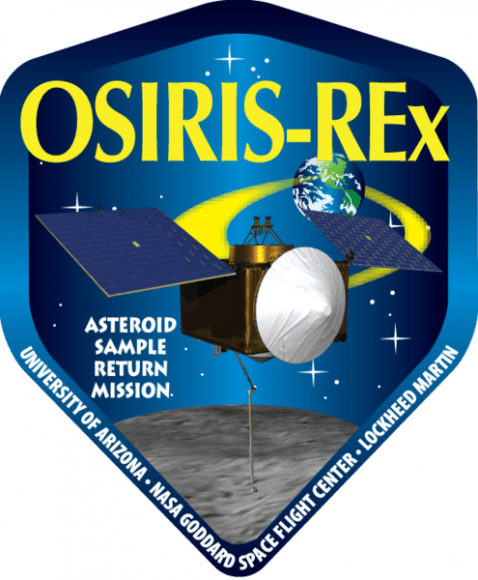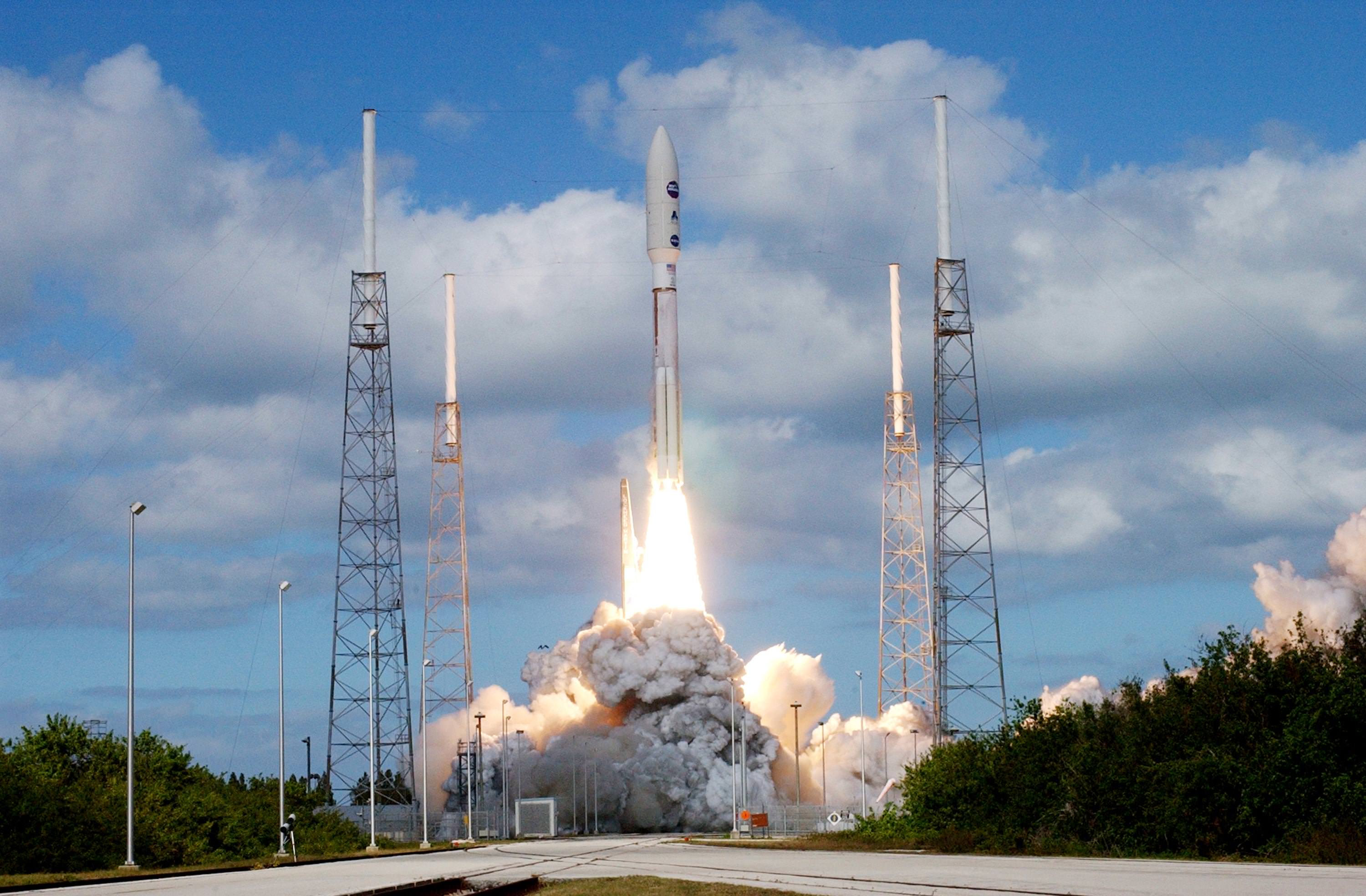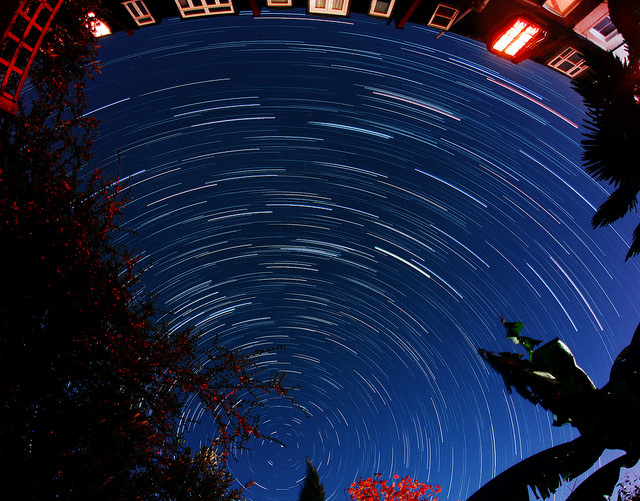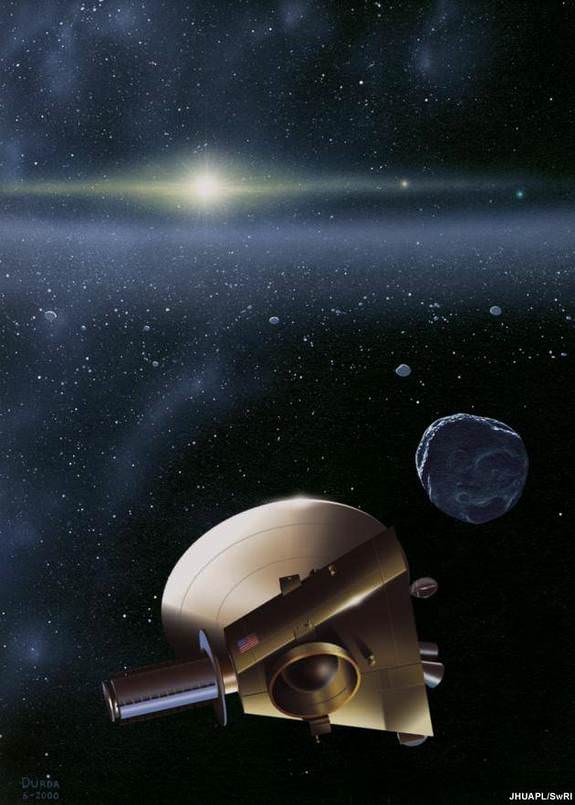Pluto’s largest moon, Charon, started off as a beautiful, smooth red grape until someone came along, mostly peeled it, tried to smoosh it, then just gave up and walked away, leaving the poor moon to look like the absolute travesty that it is. Okay, so maybe that’s not exactly what happened, but Charon just looks like a mess and scientists want to know why. Never mind its smooshed equator, but what’s the deal with its red cap? Where did it come from and why is it red?
Continue reading “Charon’s Red Cap at its North Pole? We Might Have an Answer”Catching Earth at Aphelion
Do you feel a little… distant today? The day after the 4th of July weekend brings with it the promise of barbecue leftovers and discount fireworks. It also sees our fair planet at aphelion, or its farthest point from the Sun. In 2015, aphelion (or apoapsis) occurs at 19:40 Universal Time (UT)/3:40 PM EDT today, as we sit 1.01668 astronomical units (AU) from the Sun. This translates to 152.1 million kilometres, or 94.5 million miles. We’re actually 3.3% closer to the Sun in early January than we are today. This also the latest aphelion has occurred on the calendar year since 2007, and it won’t fall on July 6th again until 2018. The insertion of an extra day every leap year causes the date for Earth aphelion to slowly vary between July 3rd and July 6th in the current epoch.
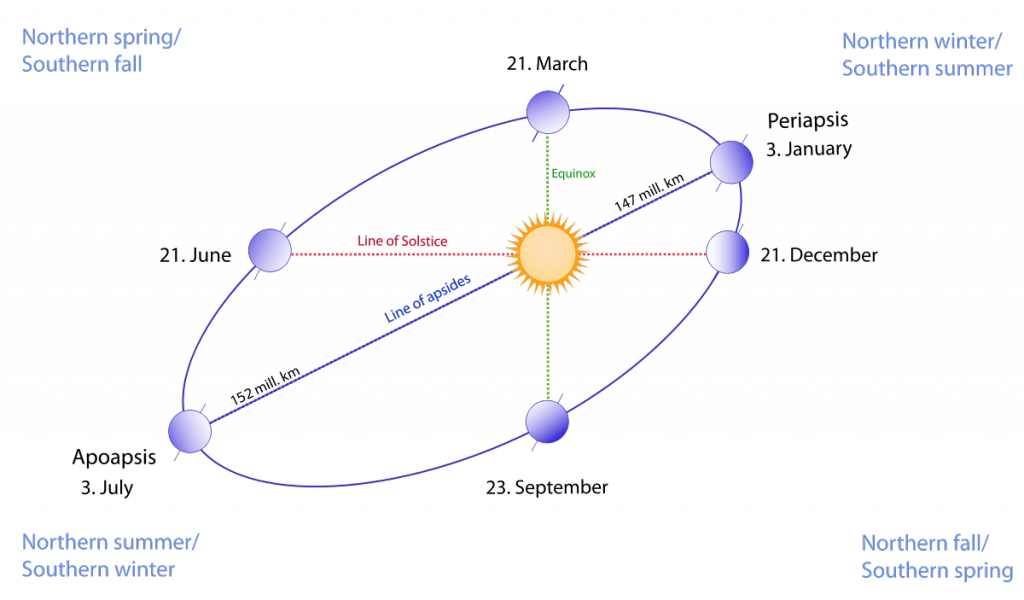
Aphelion sees the Earth 4.8 million kilometers farther from the Sun than perihelion in early January. The eccentricity of our orbit—that is, how much our planet’s orbit varies from circular to elliptical—currently sits at 0.017 or 1.7%.
It is ironic that we’re actually farther from the Sun in the middle of northern hemisphere summer. It sure doesn’t seem like it on a sweltering Florida summer day, right? That’s because the 23.44 degree tilt of the Earth’s rotational axis is by far the biggest driver of the seasons. But our variation in distance from the Sun does play a factor in long term climate as well. We move a bit slower farther from the Sun, assuring northern hemisphere summers are currently a bit longer (by about 4 days) than winters. The variation in solar insolation between aphelion and perihelion currently favors hot dry summers in the southern hemisphere.

But these factors are also slowly changing as well.
The eccentricity of our orbit varies from between 0.000055 and 0.0679 over a span of a ‘beat period’ of 100,000 years. Our current trend sees eccentricity slowly decreasing.
The tilt of our rotational axis varies between 22.1 and 24.5 degrees over 41,000 years. This value is also currently on a decreasing trend towards its shallow minimum around 11,800 AD.
And finally, the precession of the Earth’s axis and apsidal precession combine to slowly move the date of aphelion and perihelion one time around our calendar once every 21,000 years.
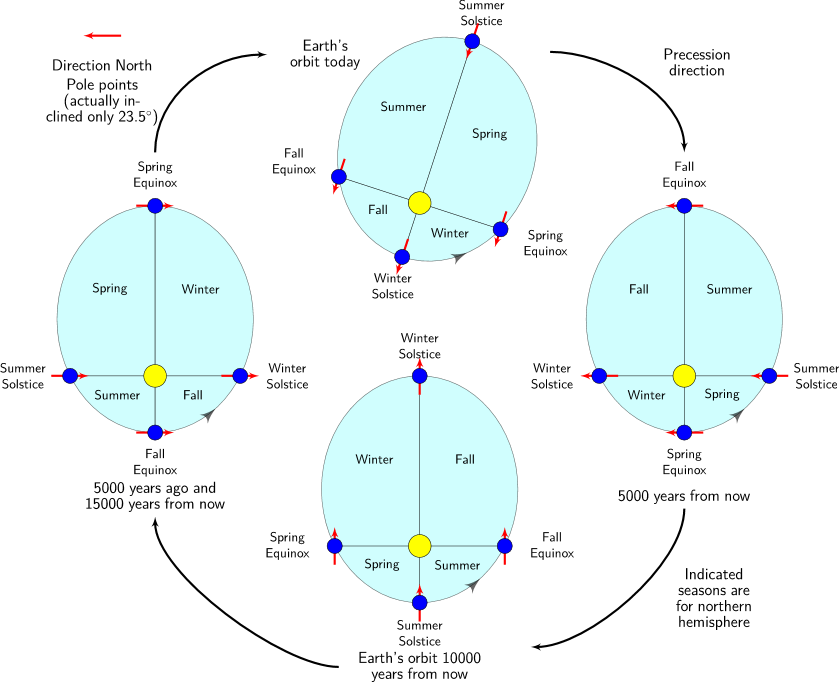
These combine to form what are known as Milankovitch Cycles of long-term climate variation, which were first expressed by astronomer Milutin Milankovic in 1924. Anthropogenic climate change is a newcomer on the geologic scene, as human civilization does its very best to add a signal of its very own to the mix.
We also just passed the mid-point ‘pivot of the year’ on July 2nd. More than half of 2015 is now behind us.
Want to observe the aphelion and perihelion of the Earth for yourself? If you have a filtered rig set to photograph the Sun, try this: take an image of the Sun today, and take another on perihelion next year on January 2nd. Be sure to use the same settings, so that the only variation is the angular size of the Sun itself. The disk of the Sun varies from 33’ to 31’ across. This is tiny but discernible. Such variations in size between the Sun and the Moon can also mean the difference between a total solar and annular eclipse.
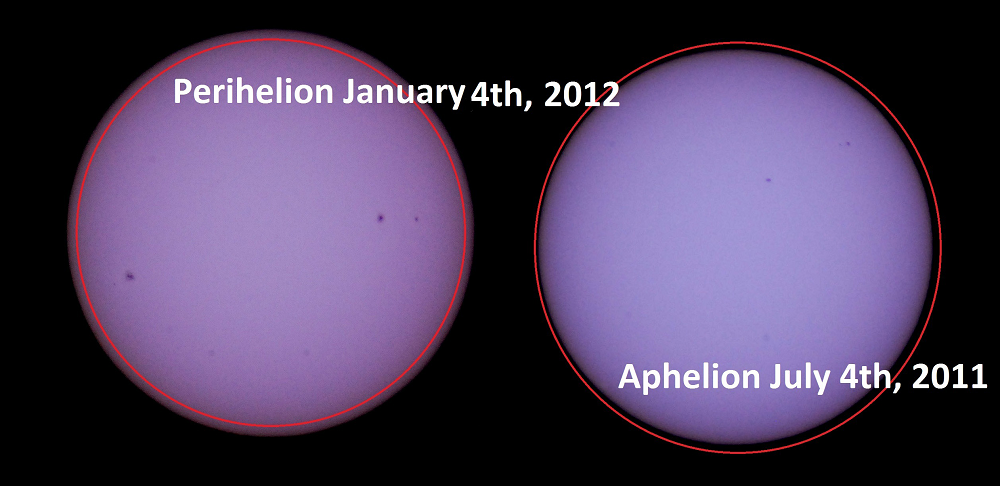
Should we term the aphelion Sun a #MiniSol? Because you can never have too many internet memes, right?
And did you know: the rotational axis of the Sun is inclined slightly versus the plane of the ecliptic to the tune of 7.25 degrees as well. In 2015, the Sun’s north pole was tipped our way on March 7th, and we’ll be looking at the south pole of our Sun on September 9th.
And of course, seasons on other planets are much more extreme. We’re just getting our first good looks at Pluto courtesy of New Horizons as it heads towards its historic flyby on July 14th. Pluto reached perihelion in 1989, and is headed towards aphelion 49 AU from the Sun on the far off date in 2114 AD. Sitting on Pluto, the Sun would shine at -19th magnitude—about the equivalent of the twilight period known as the ‘Blue Hour’ here on Earth—and the Sun would appear a scant one arc minute across, just large enough to show a very tiny disk.
All thoughts to consider as we start the long swing inward towards perihelion next January.
Happy aphelion!
See Pluto for Yourself Ahead of New Horizons’ Historic Encounter
Are you ready for July? The big ticket space event of the year is coming right up, as NASA’s New Horizons spacecraft is set to make its historic flyby targeting a pass 12,500 kilometres (7,750 miles) from the surface of Pluto at 11:50 UT on July 14th. Already, Pluto and its moons are growing sharper by the day, as New Horizons closes in on Pluto at over 14 kilometres per second.
And the good news is, this flyby of the distant world occurs just eight days after Pluto reaches opposition for 2015, marking a prime season to track down the distant world with a telescope.
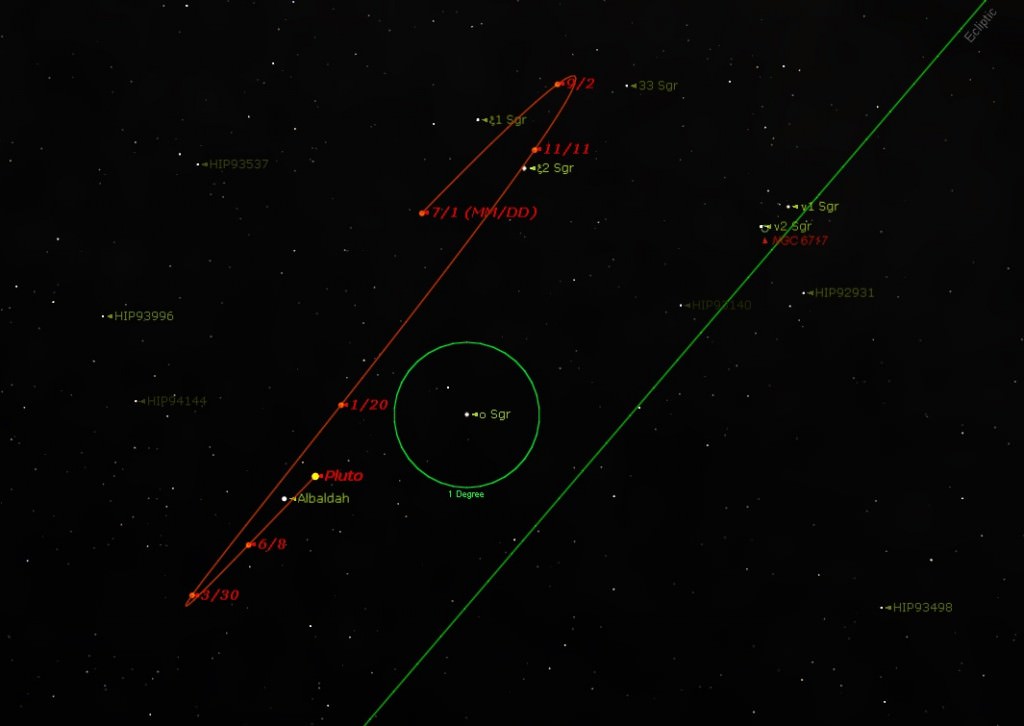
Pluto and its large moon Charon are snapping into focus as we reach the two week out mark. Discovered in 1930 by astronomer Clyde Tombaugh while working at the Lowell observatory in Flagstaff Arizona, these far off worlds are about to become real places in the public imagination. It’s going to be an exciting—if tense—few weeks, as new details and features are seen on these brave new worlds, all calling out for names. Are there undiscovered moons? Does Pluto host a ring system? What is the history of Pluto?
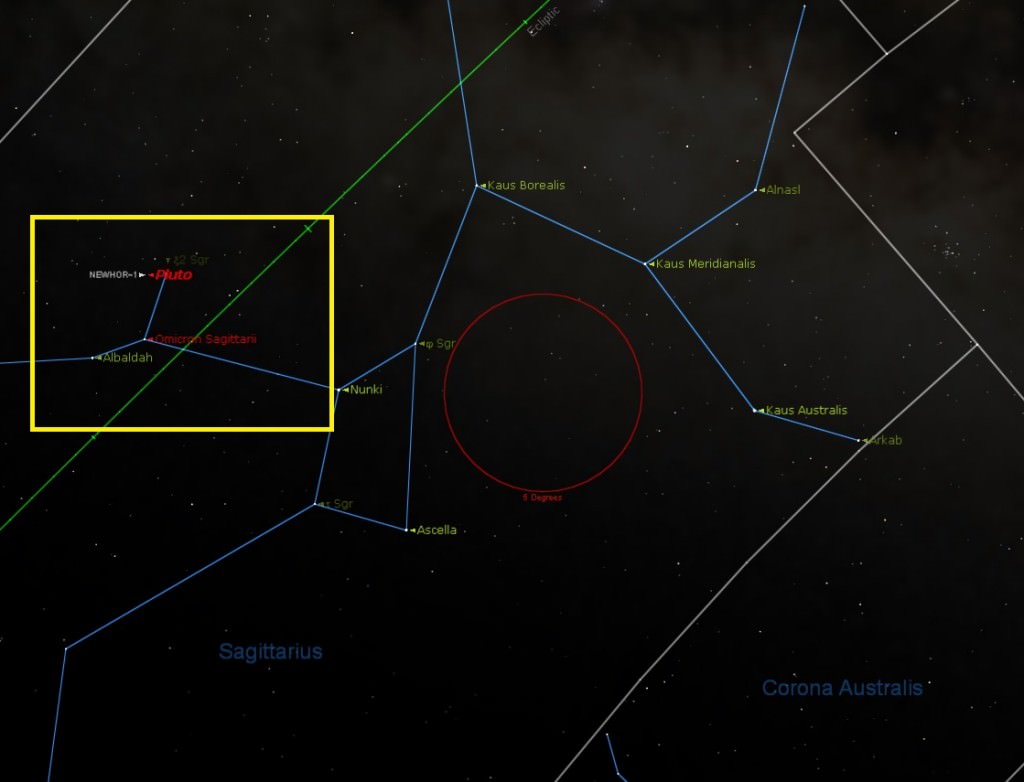
Hunting for Pluto with a backyard telescope is difficult, though not impossible. We suggest an aperture of 10-inches or greater, though the tiny world has been reliably spotted using a 6-inch reflector. Pluto reaches opposition on July 6th at 10:00 UT/6:00 AM EDT, marking a period when it will rise opposite to the setting Sun and transit highest near local midnight. Pluto spends all of 2015 in the constellation Sagittarius. This presents two difficulties: 1). We’re currently looking at Pluto against the very star-rich backdrop towards the center of the Milky Way Galaxy, and 2). Its southerly declination means that it won’t really ‘clear the weeds’ much for northern hemisphere observers.
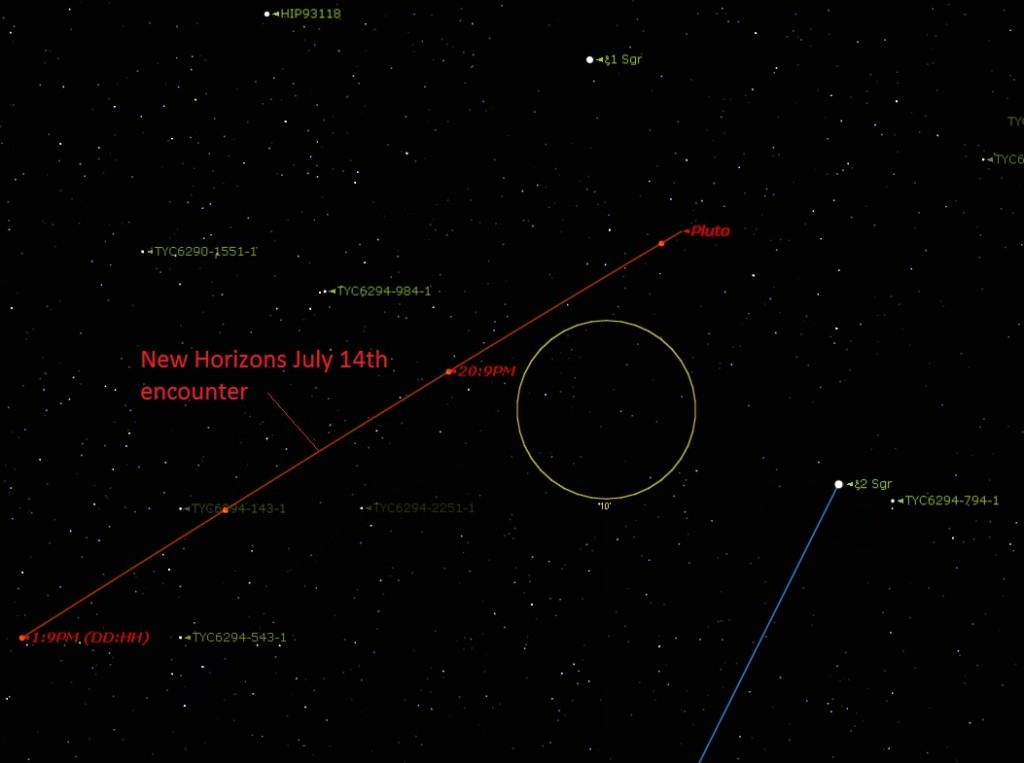
But don’t despair. With a good finder chart and patience, you too can cross Pluto off of your life list. In fact, the month of July sees Pluto thread its way between the 27’ wide +4th magnitude pair Xi Sagittarii, making a great guidepost to spot the 14th magnitude world.
Don’t own a telescope? You can still wave in the general direction of New Horizons and Pluto on the evening of July 1st, using the nearby Full Moon as a guide:
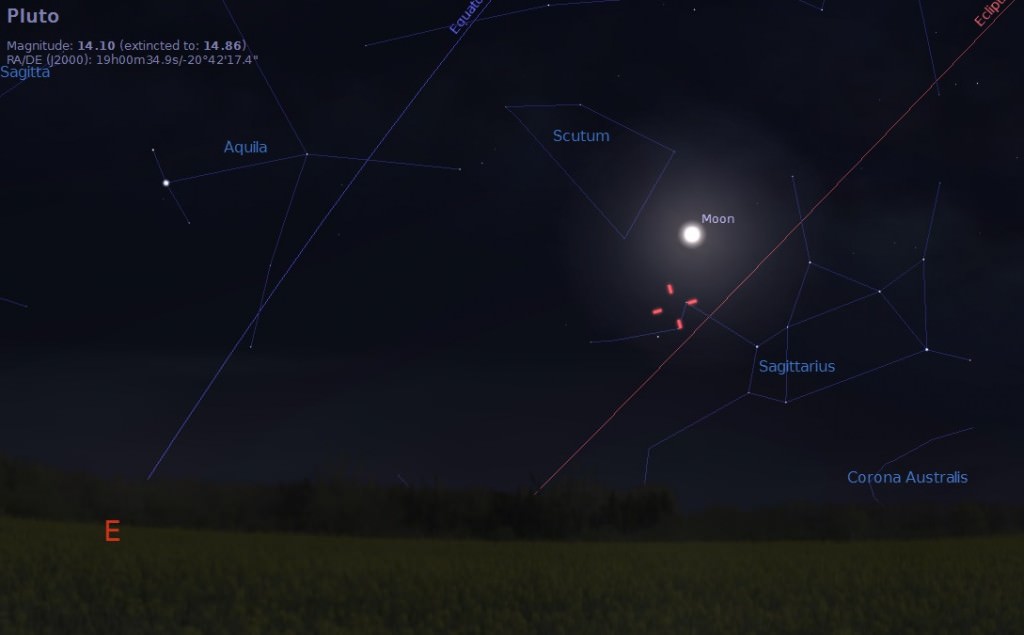
Pluto orbits the Sun once every 248 years, and reaches opposition every 367 days. A testament to this slow motion is the fact that Mr. Tombaugh first spied Pluto south of the star Delta Gemini, and it has only moved as far as Sagittarius in the intervening 85 years. Pluto also passed perihelion in 1989, when it was about half a magnitude brighter than it currently is now. Pluto’s distance from the Sun varies from 30 AU to 49 AU, and Pluto will reach aphelion just under a century from now on 2114.
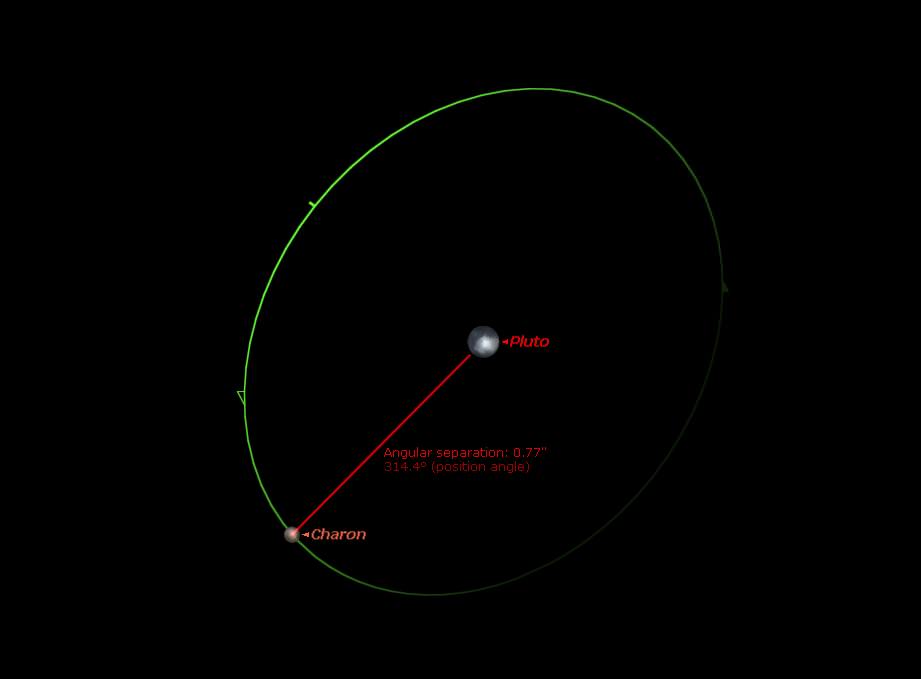
Up for a challenge? Hunting down Pluto’s elusive moon Charon is an ultimate feat of astronomical athletics. Amazingly, this has actually been done before, as reported here in 2008 on Universe Today.
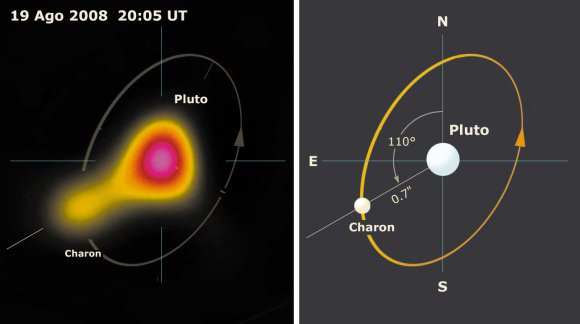
Charon reaches greatest elongation 0.8” from Pluto once every three days. Shining at +16th magnitude, Charon is a faint catch, though not impossible. We’re already seeing supporting evidence from early New Horizons images that these two worlds stand in stark contrast, with dark Charon covered in relatively low albedo dirty water-ice and while brighter Pluto is coated with reflective methane snow.

The current forward-looking view from New Horizons of Pluto is amazing to consider. As of July 1st, the spacecraft is 0.11 AU (17 million kilometres) from Pluto and closing, and the world appears as a +1.7 magnitude object about 30 arc seconds across. The views of Pluto are courtesy of New Horizons’ LORRI (Long Range Reconnaissance Imager), which in many ways is very similar to a familiar backyard 8-inch Schmidt-Cassegrain telescope. It’s interesting to note that the views we’re currently getting very closely resemble amateur views of Mars near opposition, though we suspect that will change radically in about a week.
And it will take months for all of the New Horizons data to make its way back to Earth. The real nail-biter will be the 20 hour period of close rendezvous on July 14th, a period in which the spacecraft will have to acquire Pluto and Charon, do its swift ballet act, and carry out key observations—all on its own before phoning home. This will very likely be the only mission to Pluto in our lifetimes, as New Horizons will head out to rendezvous with several Kuiper Belt Objects in the 2020 time frame before joining the Voyager I & II and Pioneer 10 & 11 spacecraft in an orbit around the Milky Way Galaxy.
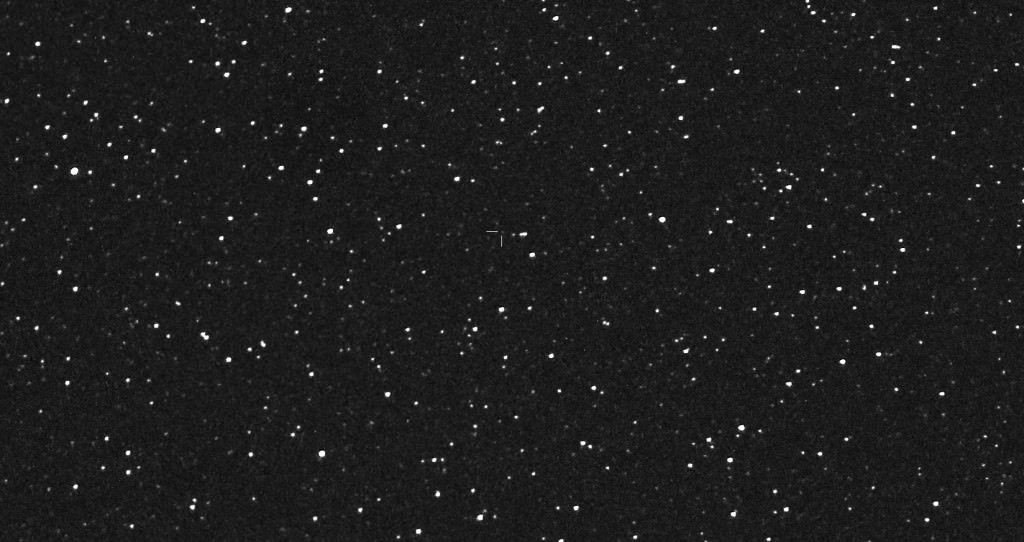
Just think, in less than a few weeks time, science writers will (at last!) have a wealth of Plutonian imagery to choose from courtesy of New Horizons, and not just a few blurry pics and artist’s conceptions that we’ve recycled for decades… let us know of your tales of tribulation and triumph as you attempt to hunt down Pluto this summer!
A Brief History of Nukes in Space
In just a few short weeks, NASA’s New Horizons spacecraft will make its historic flyby of Pluto and its moons. Solar panels are unable to operate in the dim nether regions of the outer solar system, and instead, New Horizons employs something that every spacecraft that has thus far ventured beyond Jupiter has carried in its tool kit: a plutonium-powered Radioisotope Thermoelectric Generator, or RTG.
The use of nuclear power to explore space is one of the few happy chapters of the post atomic age, and nuclear power may one day give us access to the stars.
In the 1950s, atomic energy was seen as a panacea as well as a curse, a sort of Sword of Damocles that both hung over the human race, while also holding the promise of its salvation. This was before the disasters in Fukushima Daiichi, Chernobyl and Three Mile Island, which would serve to sour the public to all things nuclear.

But early space pioneers also recognized the potential for nuclear energy in space exploration. One of the more bizarre proposals of the early Space Age was a plan named Project A119 which called for the United States to detonate a nuclear weapon on the Moon in full view of the Soviet Union as a show of power. Another interesting proposal dubbed Project Orion called for the construction of an interstellar spacecraft that would be propelled by atomic bombs detonated to its aft. And the very first human artifact shot into space may well have been a one ton steel plate that was accidentally propelled at high speed skyward during the Pascal B nuclear test in the Operation Plumbbob series on August 27th, 1957. And the United States did indeed detonate nuclear weapons in space before the advent of the Limited Test Ban Treaty of 1967 that later forbade such tests. One amazing (and, as a child of the Cold War, very eerie to watch) such test known as Starfish Prime was carried out over the South Pacific in 1962:
One of the first spacecraft that sported an RTG was the Transit-4A satellite launched on June 29th, 1961. Another similar satellite in the series, Transit-5BN-3, was lost shortly after launch along with its plutonium-fueled RTG, which reentered over the Indian Ocean. The Soviet satellite Kosmos 954 also reentered over the Canadian high Arctic in early 1978 along with its onboard nuclear reactor.
And when Apollo 13 returned to Earth, the crew jettisoned the Aquarius lunar landing module over the Pacific, where it reentered along with its plutonium RTG meant for the ALSEP experiments that the Apollo astronauts placed on the Moon during every mission.

Every launch from Cape Canaveral of a nuclear RTG is sure to draw a scattering of protesters, though NASA estimated a catastrophic launch failure involving an RTG rupture during the New Horizons launch at 1-in-360. These fears reached a crescendo during the launch of Cassini in 1997, which also featured an Earth slingshot flyby on August 18th, 1999 en route to Saturn.
A nuclear RTG works by utilizing the waste heat generated by the radioactive decay of plutonium-238. This not only has a half-life of 87.7 years, but it also generates a very respectable 560 watt-seconds per kilogram per second. Unfortunately, the stuff we weaponize for nuclear bombs is a separate isotope known as Pu-239, and it can’t be repurposed for RTG use. The production of plutonium-239 for nuclear weapons during the Cold War did, however, also assure that the capability to also create Pu-238 for spaceflight was on hand until production was ended in the United States in 1989.

A roll call of RTG-equipped spacecraft reads like a ‘Who’s Who’ of outer solar system space exploration and includes: Pioneer 10 and 11, Galileo, Cassini, the Mars Science Laboratory, Voyagers 1 and 2, Vikings 1 and 2, and the aforementioned New Horizons spacecraft bound for Pluto.
Fun Fact: the plutonium powering Curiosity as it explores Mars was actually bought by NASA from the Russians.
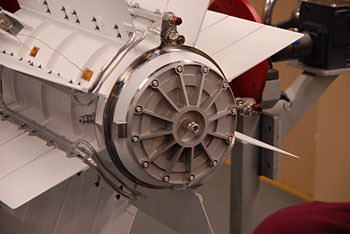
As of this writing, the Mars Rover 2020 mission is the next spacecraft to break the surly bonds that will sport, like Curiosity, a plutonium-powered MMRTG. A proposed Uranus Orbiter mission named HORUS (This stands for—deep breath— the Herschel Orbiter for Reconnaissance of the Uranus System, because ‘Uranus Probe’ just doesn’t sound right) would have also utilized and RTG. The Europa Clipper mission to Jupiter’s moon Europa set to launch around 2025 chose solar cells over a nuclear RTG, though it’ll have to thread through the perilous radiation environment surrounding Jupiter. In fact, the Juno spacecraft set to enter orbit around the planet Jupiter next year will be the first Jovian mission that won’t utilize nuclear power, though it requires three enormous solar panels to compensate.
Just how much plutonium NASA has on hand courtesy of the Department of Energy is classified for security reasons, but it’s thought to have enough for one large and one scout-class mission remaining. New Horizons incorporates 10.9 kilograms of plutonium, and it’s interesting to note that any alien civilization that finds a human spacecraft orbiting the plane of our Milky Way galaxy millions of years hence could date its manufacture from the radioactive decay of what very little Pu-238 versus decay isotopes remains in its RTG.

NASA has announced that the US Department of Energy will indeed resume the production of plutonium to the tune of about 1.5 to 2 kilograms a year starting in 2016. On the downside, NASA did, however, halt the development of its Advanced Stirling Radioisotope Generator (ASRG) in 2013. This is a somewhat contradictory decision, fueled more by politics than practicality given the current scarcity of plutonium. The ASRG design was to be four times more efficient than current MMRTGs (MM stands for Multi-Mission) and would have thus utilized less of the dwindling stockpile of existing Pu-238.
Sadly, the lingering shortage of plutonium may have a dire impact on the future of outer solar system space exploration. As Cassini, New Horizons and the Voyager spacecraft wrap up their respective missions, our ‘eyes on the outer solar system’ may go dark, as the current golden era of planetary exploration draws to a close for now, or at least, awaits a new generation of plutonium-powered spacecraft to take up the mantle.
OSIRIS-REx Asteroid Sampler Enters Final Assembly
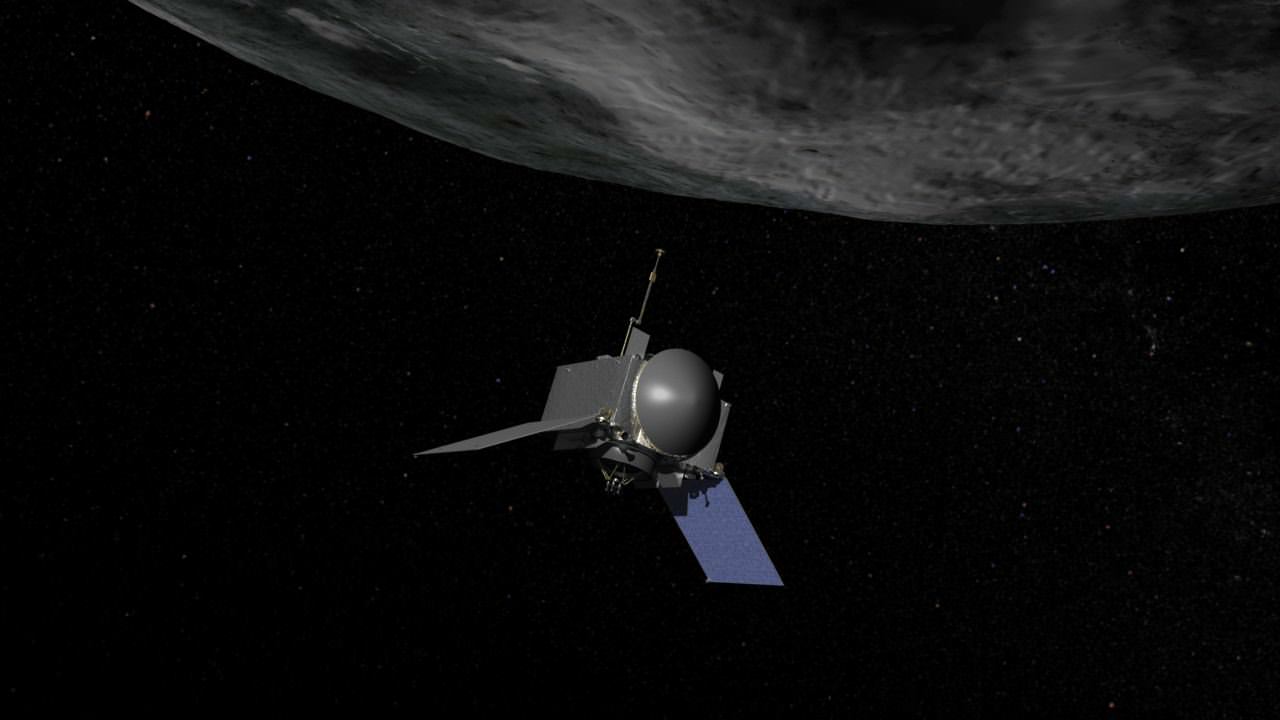
OSIRIS-Rex, NASA’s first ever spacecraft designed to collect and retrieve pristine samples of an asteroid for return to Earth has entered its final assembly phase.
Approximately 17 months from now, OSIRIS-REx is slated to launch in the fall of 2016 and visit asteroid Bennu, a carbon-rich asteroid.
Bennu is a near-Earth asteroid and was selected for the sample return mission because it “could hold clues to the origin of the solar system and host organic molecules that may have seeded life on Earth,” says NASA.
The spacecraft is equipped with a suite of five science instruments to remotely study the 492 meter meter wide asteroid.
Eventually it will gather rocks and soil and bring at least a 60-gram (2.1-ounce) sample back to Earth in 2023 for study by researchers here with all the most sophisticated science instruments available.
The precious sample would land arrive at Utah’s Test and Training Range in a sample return canister similar to the one for the Stardust spacecraft.
The OSIRIS-REx – which stands for Origins, Spectral Interpretation, Resource Identification, Security, Regolith Explorer – spacecraft passed a critical decision milestone on the road to launch and has been officially authorized by NASA to transition into this next mission phase.
The decision meeting to give the go ahead for final assembly was held at NASA Headquarters in Washington on March 30 and was chaired by NASA’s Science Mission Directorate, led by former astronaut John Grunsfeld who was the lead spacewalker on the final shuttle servicing mission to the Hubble Space Telescope in 2009.
“This is an exciting time for the OSIRIS-REx team,” said Dante Lauretta, principal investigator for OSIRIS-Rex at the University of Arizona, Tucson, in a stetement.
“After almost four years of intense design efforts, we are now proceeding with the start of flight system assembly. I am grateful for the hard work and team effort required to get us to this point.”
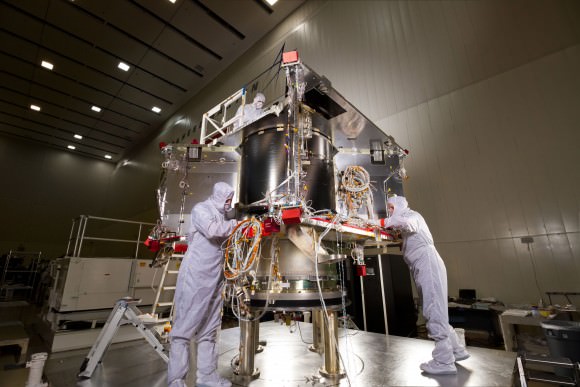
The transition to the next phase known as ATLO (assembly, test and launch operations) is critical for the program because it is when the spacecraft physically comes together, says Lockheed Martin, prime contractor for OSIRIS-REx. Lockheed is building OSIRIS-Rex in their Denver assembly facility.
“ATLO is a turning point in the progress of our mission. After almost four years of intense design efforts, we are now starting flight system assembly and integration of the science instruments,” noted Lauretta.
Over the next six months, technicians will install on the spacecraft structure its many subsystems, including avionics, power, telecomm, mechanisms, thermal systems, and guidance, navigation and control, according to NASA.
“Building a spacecraft that will bring back samples from an asteroid is a unique opportunity,” said Rich Kuhns, OSIRIS-REx program manager at Lockheed Martin Space Systems, in a statement.
“We can feel the momentum to launch building. We’re installing the electronics in the next few weeks and shortly after we’ll power-on the spacecraft for the first time.”
OSIRIS-REx is scheduled for launch in September 2016 from Cape Canaveral Air Force Station in Florida aboard a United Launch Alliance Atlas V 411 rocket, which includes a 4-meter diameter payload fairing and one solid rocket motor. Only three Atlas V’s have been launched in this configuration.
“In just over 500 days, we will begin our seven-year journey to Bennu and back. This is an exciting time,” said Lauretta.
The spacecraft will reach Bennu in 2018 and return a sample to Earth in 2023.
Bennu is an unchanged remnant from the collapse of the solar nebula and birth of our solar system some 4.5 billion years ago, little altered over time.
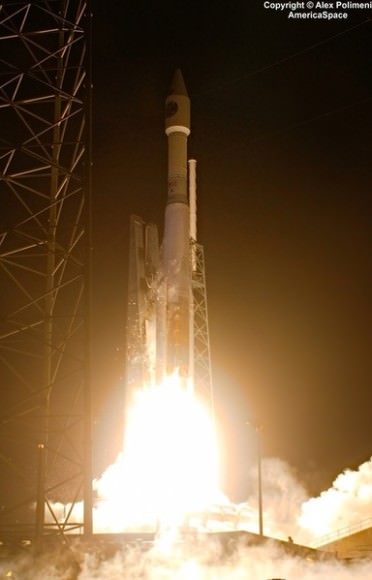
Significant progress in spacecraft assembly has already been accomplished at Lockheed’s Denver manufacturing facility.
“The spacecraft structure has been integrated with the propellant tank and propulsion system and is ready to begin system integration in the Lockheed Martin highbay,” said Mike Donnelly, OSIRIS-REx project manager at NASA’s Goddard Space Flight Center in Greenbelt, Maryland, in a statement.
“The payload suite of cameras and sensors is well into its environmental test phase and will be delivered later this summer/fall.”
OSIRIS-REx is the third mission in NASA’s New Frontiers Program, following New Horizons to Pluto and Juno to Jupiter, which also launched on Atlas V rockets.
The most recent Atlas V launched NASA’s MMS quartet of Earth orbiting science probes on March 12, 2015.
NASA’s Goddard Space Flight Center in Greenbelt, Maryland, is responsible for overall mission management.
OSIRIS-REx complements NASA’s Asteroid Initiative – including the Asteroid Redirect Mission (ARM) which is a robotic spacecraft mission aimed at capturing a surface boulder from a different near-Earth asteroid and moving it into a stable lunar orbit for eventual up close sample collection by astronauts launched in NASA’s new Orion spacecraft. Orion will launch atop NASA’s new SLS heavy lift booster concurrently under development.
Stay tuned here for Ken’s continuing Earth and planetary science and human spaceflight news.
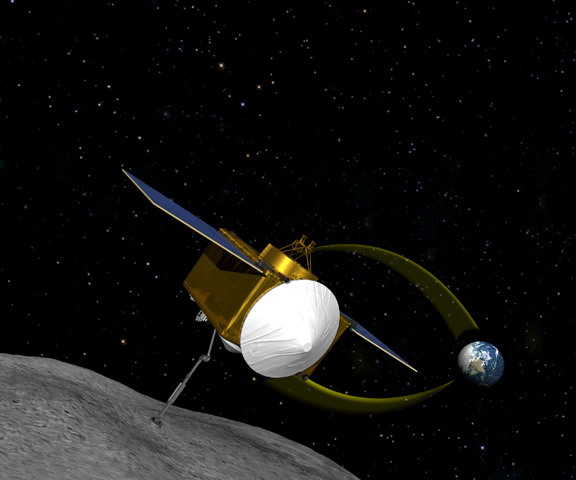
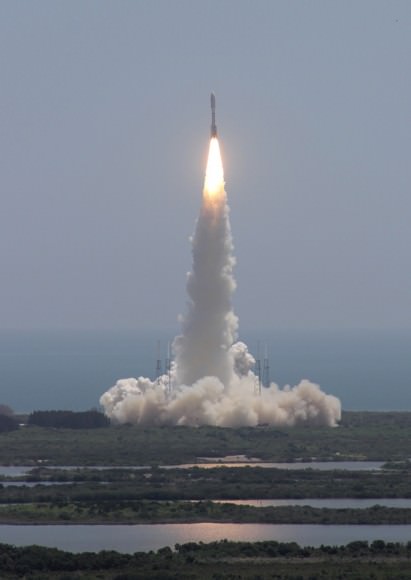
10 Space Science Stories to Watch in 2015
A new Avengers movie. A reboot of the Star Wars franchise. The final installment of the Hunger Games. The Martian makes it to the big screen. Yup, even if the zombie apocalypse occurs in 2015, it’ll still be a great year. But trading science fiction for fact, we’re also on track for a spectacular year in space science and exploration as well.
Humanity will get its first good look at Ceres and Pluto, giving us science writers some new pics to use instead of the same half dozen blurry dots and artist’s conceptions. SpaceX will also attempt a daring landing on a sea platform, and long duration missions aboard the International Space Station will get underway. And key technology headed to space and on Earth may lead the way to opening up the window of gravitational wave astronomy on the universe. Here’s 10 sure-fire bets to watch for in the coming year from Universe Today:
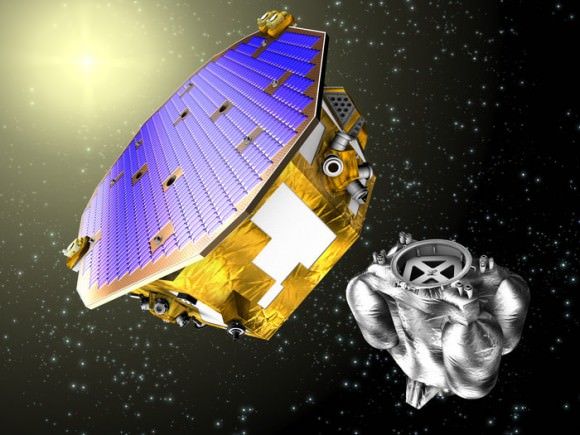
10. LISA Pathfinder
A precursor to a full-fledged gravitational wave detector in space, LISA Pathfinder will be launching atop a Vega rocket from Kourou, French Guiana in July 2015. LISA stands for the Laser Interferometer Space Antenna, and the Pathfinder mission will journey to the L1 Lagrange point between the Earth and the Sun to test key technologies. LISA Pathfinder will pave the way for the full fledged LISA space platform, a series of three free flying spacecraft proposed for launch in the 2030s.

9. AdLIGO Goes Online
And speaking of gravitational waves, we may finally get the first direct detection of the same in 2015, when Advanced LIGO is set to go online. Comprised of two L-shaped detectors, one based in Livingston Louisiana, and another in Hanford Washington, AdLIGO will feature ten times the sensitivity of the original LIGO observatory. In fact, as was the case of the hunt for the Higgs-Boson by CERN, a non-detection of gravitational waves by AdLIGO would be a much stranger result!
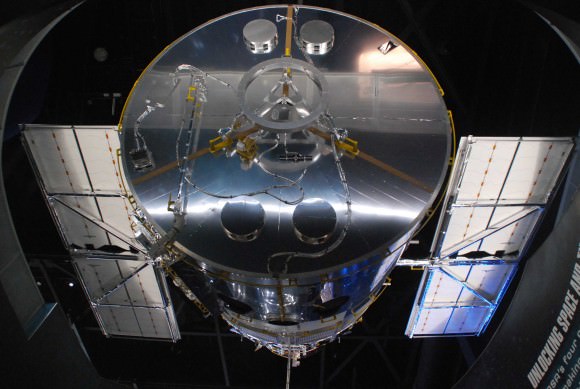
8. Hubble Turns 25
Launched on April 24th, 1990 aboard the Space Shuttle Discovery, the Hubble Space Telescope celebrates 25 years in space in 2015. The final servicing mission in 2009 gave Hubble a reprieve from the space junk scrap heap, and the orbiting telescope is still going strong. Hubble has no less than pushed the limits in modern astronomy to become a modern icon of the space age.
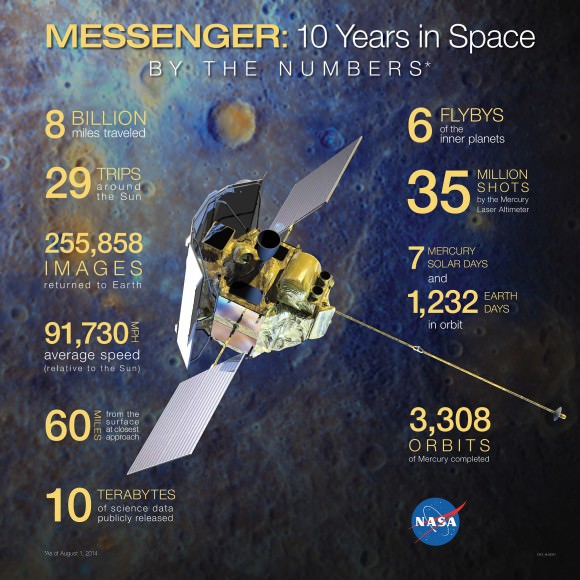
7. The End of MESSENGER
NASA’s Mercury exploring spacecraft wraps up its mission next year. Launched in 2004, MESSENGER arrived in orbit around Mercury after a series of flybys on March 18th, 2011. MESSENGER has mapped the innermost world in detail, and studied the space environment and geology of Mercury. In late March 2015, MESSENGER will achieve one final first, when it impacts the surface of Mercury at the end of its extended mission.
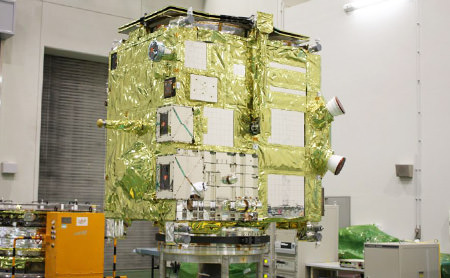
6. Akatsuki at Venus
This Japanese spacecraft missed orbital insertion a few years back, but gets a second chance at life in 2015. Launched in 2010 atop an H-IIA rocket from the Tanegashima Space Center in Japan, Akatsuki failed to enter orbit around Venus at the end of 2010, and instead headed out for a heliocentric path around the Sun. Some quick thinking by JAXA engineers led to a plan to attempt to place Akatsuki in Venusian orbit in November 2015. This would be a first for the Japanese space agency, as attempts by JAXA at placing a spacecraft in orbit around another planet – including the Mars Nozomi probe – have thus far failed.
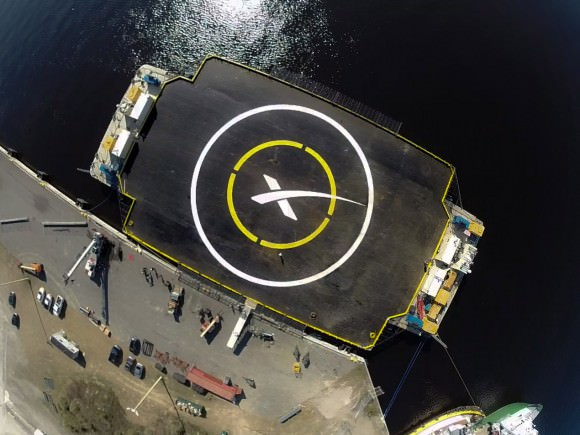
5. SpaceX to Attempt to Land on a Sea Platform
It’ll definitely rock if they pull it off next week: on January 6th, a SpaceX Falcon 9 rocket will lift off from Cape Canaveral with its Dragon spacecraft headed to the International Space Station on mission CRS-5. Sure, these resupply missions are becoming routine, but after liftoff, SpaceX is attempting something new and daring: landing the Falcon-9 first stage Buck Rodgers style, “fins first” on a floating barge. This is the next step in ultimately proving the feasibility of having the rocket fly back to the launch site for eventual reuse. If nothing else, expect some stunning video of the attempt soon!
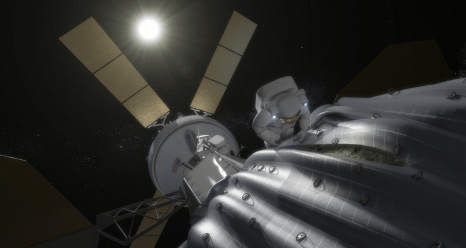
4. NASA to Decide on an Asteroid Mission
Some major decisions as to the fate and the future of manned space exploration are due next year, as NASA is expected to decide on the course of action for its Asteroid Redirect Mission. The current timeline calls for the test of the SLS rocket in 2018, and the launch of a spacecraft to recover an asteroid and place it in orbit around the Moon in 2019. If all goes according to plan – a plan which could always shift with the political winds and future changes in administrations – we could see astronauts exploring a captured asteroid by the early 2020s.
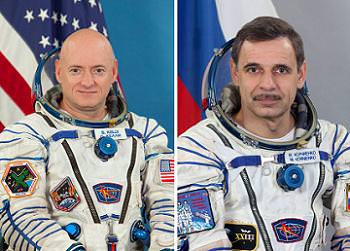
3. Long Duration ISS Missions
Beginning in 2015, astronauts and cosmonauts will begin year-long stays aboard the ISS to study the effects of long duration space missions. In March of 2015, cosmonaut Mikhail Korniyenko and U.S. astronaut Scott Kelly will launch as part of Expedition 43 headed to the ISS. The Russians have conducted stays in space longer than a year aboard the Mir space station, but Kelly’s stay aboard the ISS will set a duration record for NASA astronauts. Perhaps, a simulated “Mars mission” aboard the ISS could be possible in the coming years?
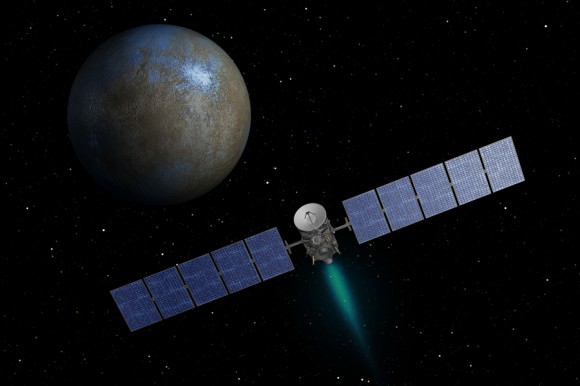
2. Dawn at Ceres
Fresh off of exploring Vesta, NASA’s Dawn spacecraft will become the first mission to enter orbit around a second object, the asteroid 1 Ceres next year in April 2015. The largest asteroid and the first object of its kind discovered on the first day of the 19th century, Ceres looks to be a fascinating world in its own right. Does it possess water ice? Active geology? Moons of its own? If Dawn’s performance at Vesta was any indication, we’re in for another exhilarating round of space exploration!
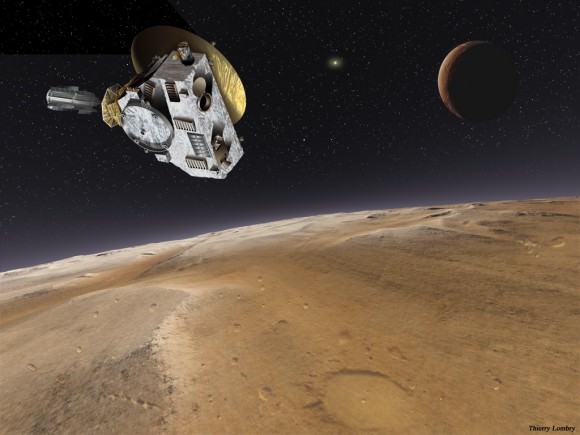
1. New Horizons at Pluto
An easy No. 1,we finally get our first good look at Pluto in July, as NASA’s New Horizons spacecraft flies less than 14,000 kilometres from the surface of the distant world. Launched in 2006, New Horizons will “thread the needle” between Pluto and Charon in a flurry of activity as it passes by. New Horizons will then turn back as it passes into the shadows of Pluto and Charon and actually view the two worlds as they occult the distant Sun. And from there, New Horizons will head out to explore Kuiper Belt Objects of opportunity.
And these are just the top stories that are slated to be big news in space in 2015. Remember, another Chelyabinsk meteor or the next big comet could drop by at any time… space news can be unpredictable, and its doubtless that 2015 will have lots more surprises in store.
The Top 101 Astronomical Events to Watch for in 2015
Phew! It’s here.
Now in its seventh year of compilation and the second year running on Universe Today, we’re proud to feature our list of astronomical happenings for the coming year. Print it, bookmark it, hang it on your fridge or observatory wall. Not only is this the yearly article that we jokingly refer to as the “blog post it takes us six months to write,” but we like to think of it as unique, a mix of the mandatory, the predictable and the bizarre. It’s not a 10 ten listicle, and not a full-fledged almanac, but something in between.
A rundown of astronomy for 2015: There’s lots of astronomical action to look forward to in the coming year. 2015 features the minimum number of eclipses that can occur, two lunars and two solars. The Moon also reaches its minimum standstill this coming year, as its orbit runs shallow relative to the celestial equator. The Moon will also occult all naked eye planets except Saturn in 2015, and will occult the bright star Aldebaran 13 times — once during every lunation in 2015. And speaking of Saturn, the rings of the distant planet are tilted an average of 24 degrees and opening to our line of sight in 2015 as they head towards their widest in 2018.
Finally, solar activity is trending downwards in 2015 after passing the sputtering 2014 maximum for solar cycle #24 as we now head towards a solar minimum around 2020.
Our best bets: Don’t miss these fine celestial spectacles coming to a sky near YOU next year:
– The two final total lunar eclipses in the ongoing tetrad, one on April 4th and September 28th.
– The only total solar eclipse of 2015 on March 20th, crossing the high Arctic.
– A fine dusk pairing of the bright planets Jupiter and Venus on July 1st.
– Possible wildcard outbursts from the Alpha Monocerotid and Taurid meteors, and a favorable New Moon near the peak of the August Perseids.
– Possible naked eye appearances by comet Q2 Lovejoy opening 2015 and comet US10 Catalina later in the year.
– The occultation of a naked eye star for Miami by an asteroid on September 3rd.
– A series of fine occultations by the Moon of bright star Aldebaran worldwide.
The rules: The comprehensive list that follows has been lovingly distilled down to the top 101 astronomical events for 2015 worldwide. Some, such as lunar eclipses, are visible to a wide swath of humanity, while others, such as many of the asteroid occultations or the sole total solar eclipse of 2015 happen over remote locales. We whittled the list down to a “Top 101” using the following criterion:
Meteor showers: Must have a predicted ZHR greater than 10.
Conjunctions: Must be closer than one degree.
Asteroid occultations: Must have a probability ranking better than 90 and occult a star brighter than magnitude +8.
Comets: Must reach a predicted brightness greater than magnitude +10. But remember: comets don’t always read prognostications such as this, and may over or under perform at whim… and the next big one could come by at any time!
Times quoted are geocentric unless otherwise noted, and are quoted in Universal Time in a 24- hour clock format.
These events are meant to merely whet the appetite. Expect ‘em to be expounded on fully by Universe Today as they approach. We linked to the events listed where possible, and provided a handy list of resources that we routinely consult at the end of the article.
Got it? Good… then without further fanfare, here’s the top 101 astronomical events for 2015 in chronological order:
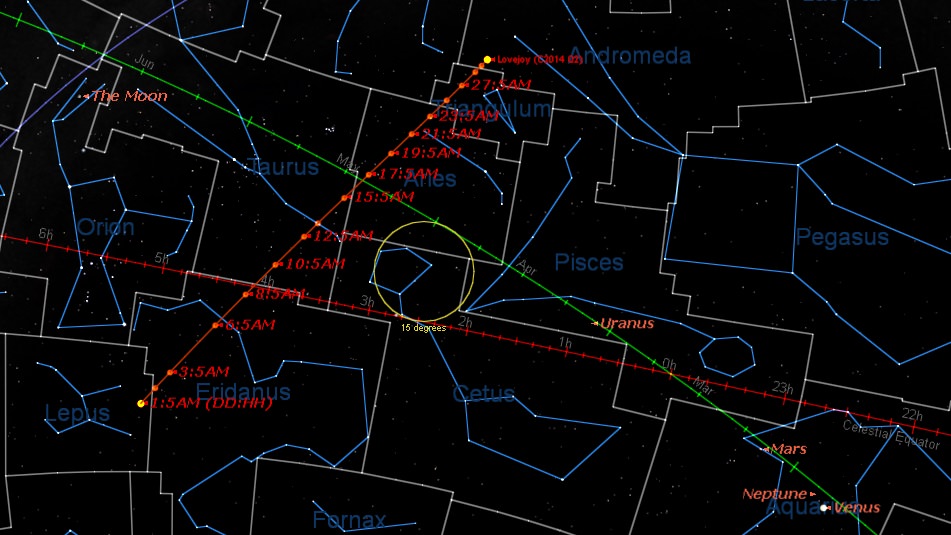
January
01- Comet C/2012 Q2 Lovejoy may reach naked eye visibility.
04- The Quadrantid meteors peak at 02:00 UT, favoring northern Europe with an expected ZHR of 120.
04- The Earth reaches perihelion at ~8:00 UT.
14- Mercury reaches greatest evening elongation 18.9 degrees east of the Sun at ~16:00 UT.
17- The moons Io and Europa cast a double shadow on Jupiter from 3:53 to 4:58 UT.
20- Mars passes 0.2 degrees from Neptune at ~20:00 UT.
24- A triple shadow transit of Jupiter’s moons occurs from 6:26 to 6:54 UT.
29- The Moon occults Aldebaran at ~17:31 UT for the Arctic, marking the first of 13 occultations of the star by the Moon in 2015.
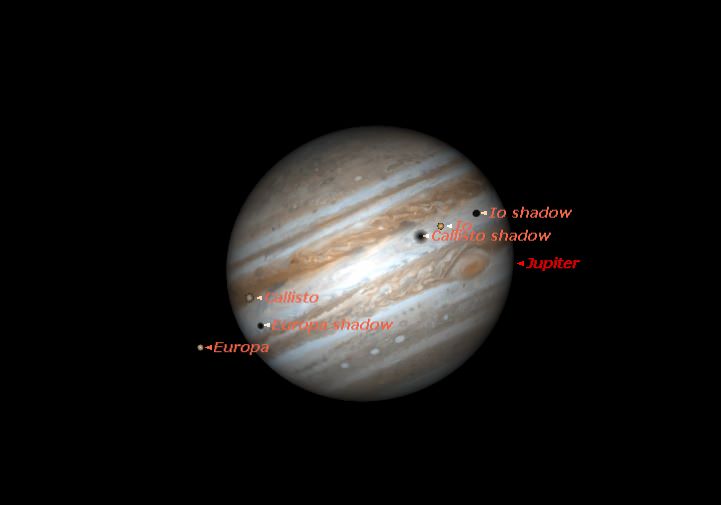
February
01- Venus passes 0.8 degrees south of Neptune at ~17:00 UT.
05- Earth crosses through Jupiter’s equatorial plane, marking the middle of occultation and eclipse season for the Galilean moons.
06- Jupiter reaches opposition at ~18:00 UT.
18- A “Black Moon” occurs, in the sense of the third New Moon in a season with four.
22- Venus passes 0.4 degrees south of Mars at 5:00 UT.
24- Mercury reaches greatest morning elongation at 26.7 degrees west of the Sun at 19:00 UT.
25- The Moon occults Aldebaran for northern Europe at 23:26 UT.
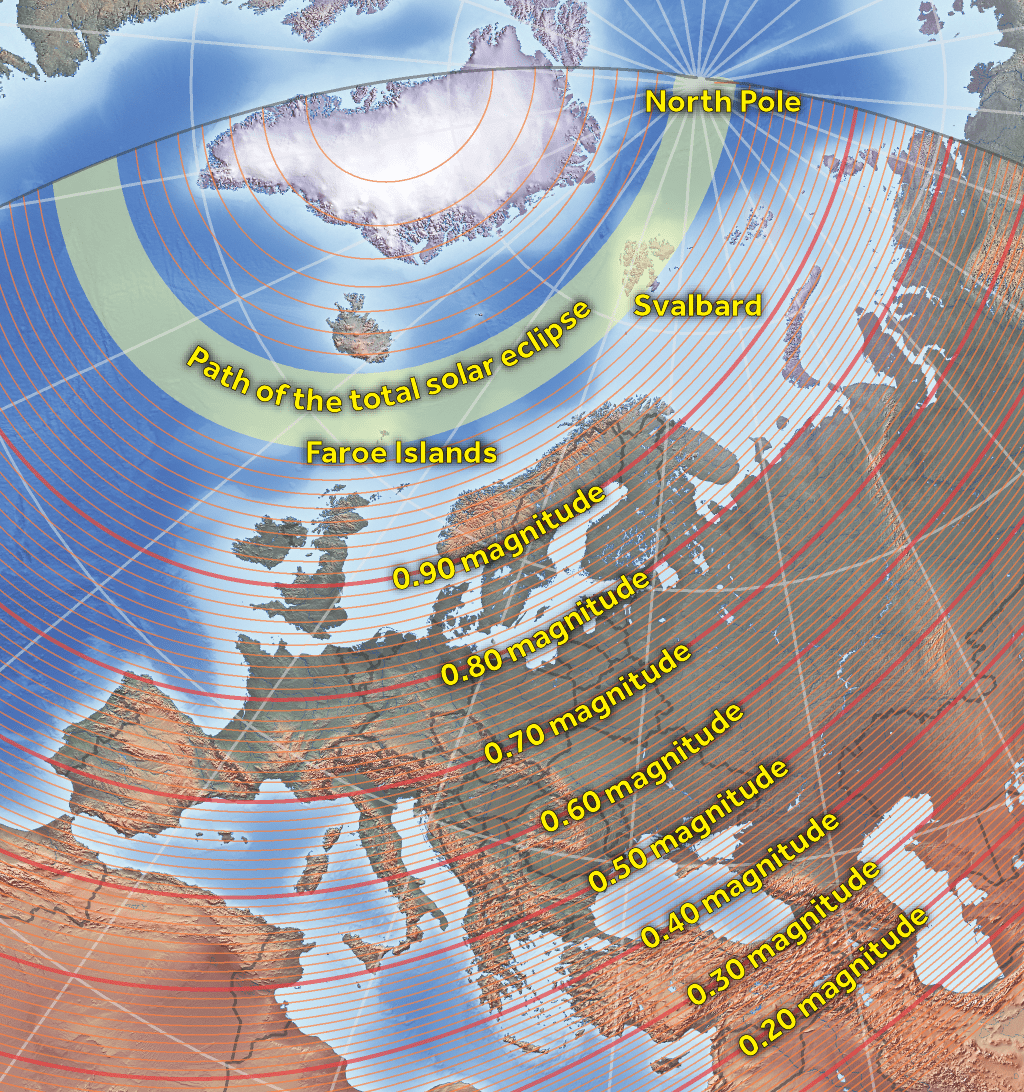
March
01- Geostationary satellite & Solar Dynamics Observatory eclipse season begins on the weeks leading up to the March Equinox.
04- Venus passes 0.1 degrees north of Uranus at ~18:00 UT. This is the closest planet-planet conjunction of 2015.
05- A Minimoon occurs, marking the most distant Full Moon of 2015 at 18:07 UT, just 10 hours from apogee.
11- Mars passes 0.3 degrees north of Uranus at ~16:00 UT.
20- A total solar eclipse occurs over the Arctic centered on 9:47 UT.
20- The March northward equinox occurs at 22:45 UT.
21- The Moon occults Mars for South America at ~22:14 UT.
25- The Moon occults Aldebaran for northwestern North America at ~7:17 UT.
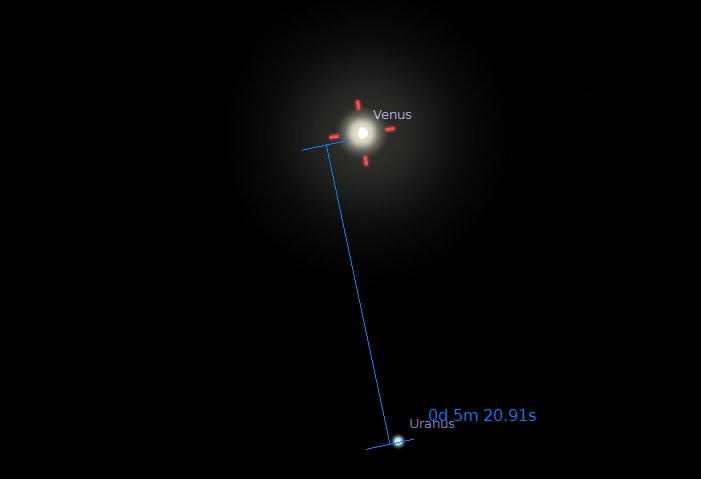
April
04- A total lunar eclipse occurs, centered on 12:01 UT and visible from eastern Asia, the Pacific and the Americas.
08- Mercury passes 0.5 degrees from Uranus at ~11:00 UT.
21- The Moon occults Aldebaran for northern Asia at ~16:57 UT.
22- The Lyrid meteors peak at 24:00 UT, favoring northern Europe with a ZHR of 18.
May
05- The Eta Aquarid meteors peak (time variable), with an estimated ZHR of 55.
07- Mercury reaches greatest evening elongation at 21.2 degrees east of the Sun at 4:00 UT.
19- The Moon occults Aldebaran for northern North America at ~2:53 UT .
20- Comet C/2014 Q1 PanSTARRS may reach binocular visibility.
21- Io and Ganymede both cast shadows on Jupiter from 00:04 to 00:33 UT.
21- Callisto and Europa both cast shadows on Jupiter from 13:26 to 13:59 UT.
23- Saturn reaches opposition at ~1:00 UT.
24- Asteroid 1669 Dagmar occults the +1st magnitude star Regulus at ~16:47 UT for the Arabian peninsula,
the brightest star occulted by an asteroid for 2015.
28- Ganymede and Io both cast shadows on Jupiter from 02:01 to 04:18 UT.
30- Comet 19P/Borrelly may reach binocular visibility.
June
01- The International Space Station reaches full illumination as the June solstice nears, resulting in multiple nightly passes favoring northern hemisphere observers.
04- Io and Ganymede both cast shadows on Jupiter from 4:54 to 6:13 UT.
05- Venus reaches greatest eastern (dusk) elongation for 2015, 45 degrees from the Sun at 16:00 UT.
10- Asteroid 424 Gratia occults a +6.1 magnitude star at ~15:10 UT for northwestern Australia.
15- The Moon occults Mercury for the South Indian Ocean at ~2:26 UT.
15- Moon occults Aldebaran in the daytime for the high Arctic at ~11:33 UT.
16- Comet C/2014 Q1 PanSTARRS may reach naked eye visibility.
21- The June northward solstice occurs at 16:38 UT.
24- Mercury reaches greatest (morning) elongation at 22.5 degrees west of the Sun at 17:00 UT.
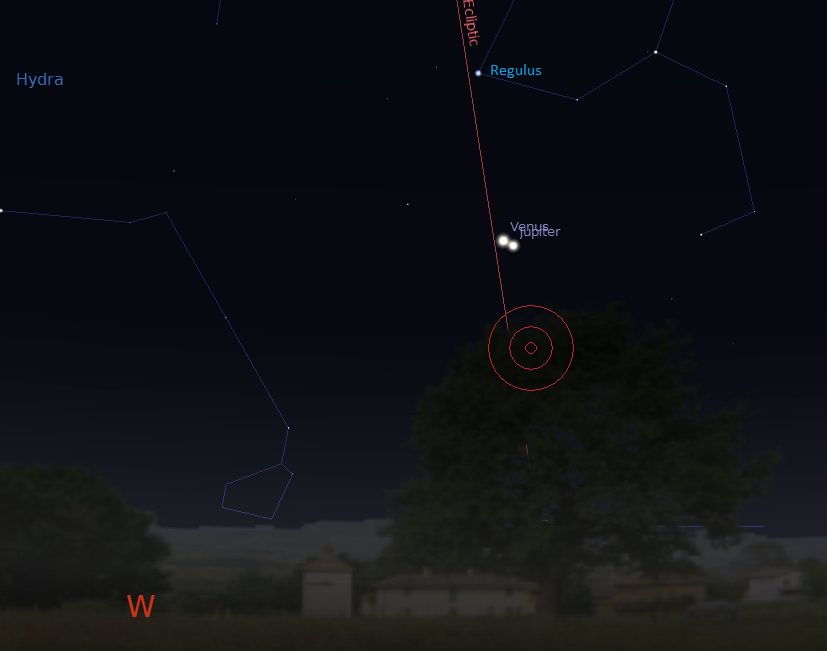
July
01- Venus passes 0.4 degrees from Jupiter at 9:00 UT, marking the closest conjunction of two naked eye planets for 2015.
02- Comet C/2013 US10 Catalina may reach binocular visibility.
06- Earth reaches aphelion at 13:00 UT.
06- Pluto reaches opposition at 15:00 UT, just a week prior to New Horizons’ historic flyby of the distant world.
12- The Moon occults Aldebaran for northeastern Asia ~18:17 UT.
19- The Moon occults Venus for the South Pacific at ~1:07 UT.
25- Asteroid 49 Pales occults a +6.6 magnitude star at 10:55 UT for Mexico.
28- The Delta Aquarids peak (time variable) with a predicted ZHR of 16.
31- A “Blue Moon” occurs, in the sense of the second Full Moon in a given month.
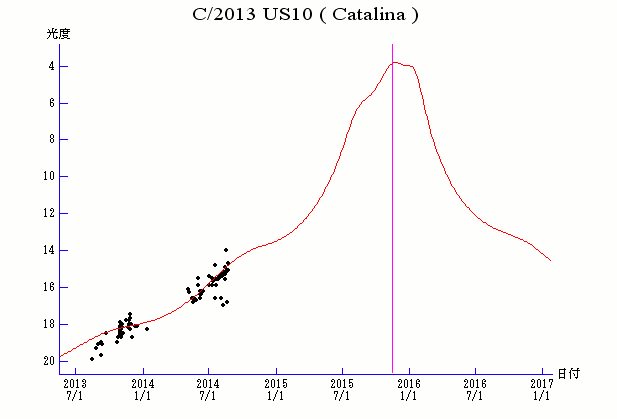
August
07- Mercury, Jupiter and Regulus pass within a degree of each other over the next few evenings.
08- The Moon occults Aldebaran for central Asia at ~23:45 UT.
13- The Perseid meteors peak from 06:30 to 09:00 UT, with a maximum predicted ZHR of 100 favoring North America.
19- Mars crosses the Beehive Cluster M44.
28- Asteroid 16 Psyche occults a +6.4 magnitude star at ~9:49 UT for Bolivia and Peru.
29- Supermoon 1 of 3 for 2015: The Moon reaches Full at 18:38 UT, 20 hours from perigee.
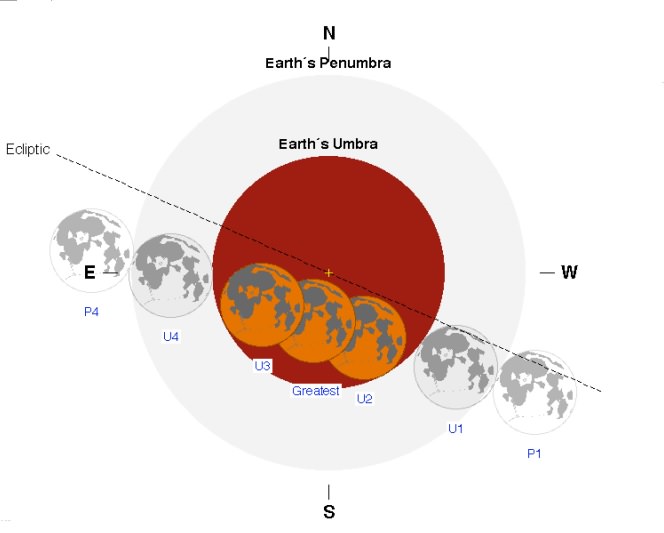
September
01- Neptune reaches opposition at ~3:00 UT.
03- Asteroid 112 Iphigenia occults a +3rd magnitude star for Mexico and Miami at ~9:20 UT. This is the brightest star occulted by an asteroid in 2015 for North America.
02- Geostationary satellite and SDO eclipse season begins as we approach the September equinox.
04- Mercury reaches its greatest elongation for 2015, at 27 degrees east of the Sun at 8:00 UT in the dusk skies.
05- The Moon occults Aldebaran for northeastern North America at ~5:38 UT.
13- “Shallow point” (also known as the minor lunar standstill) occurs over the next lunation, as the Moon’s orbit reaches a shallow minimum of 18.1 degrees inclination with respect to the celestial equator… the path of the Moon now begins to widen towards 2025.
13- A partial solar eclipse occurs, centered on 6:55 UT crossing Africa and the Indian Ocean.
23- The September southward equinox occurs at 8:20 UT.
25- Mars passes 0.8 degrees from Regulus at ~4:00 UT.
28- A total lunar eclipse occurs centered on 2:48 UT, visible from the Pacific, the Americas and eastern Europe.
28- Supermoon 2 of 3 for 2015: The Moon reaches Full at 2:52 UT, approximately an hour from perigee. This marks the closest Full Moon of the year.

October
01- Comet C/2013 US10 Catalina may reach naked eye visibility.
02- The Moon occults Aldebaran for the northern Pacific at 13:14 UT.
02- Io and Callisto both cast shadows on Jupiter from 12:26 to 13:35 UT.
08- The Moon occults Venus for Australia at ~20:32 UT.
11- The Moon occults Mercury for Chile at ~12:00 UT.
12- Uranus reaches opposition at ~3:00 UT.
16- Mercury reaches greatest elongation (morning) 18.1 degrees west of the Sun at 10:00 UT.
17- Mars passes 0.4 degrees from Jupiter at 22:00 UT.
18- Io and Ganymede both cast shadows on Jupiter from 10:45 to 12:10 UT.
21- The Orionid meteors peak (time variable) with a projected ZHR of 15.
25- Venus passes 1 degree from Jupiter ~19:00 UT.
25- Io and Ganymede both cast shadows on Jupiter from 12:37 to 14:51 UT.
27- Supermoon 3 of 3 for 2015: The Moon reaches Full at 12:06 UT, 23 hours from perigee.
29- The Moon occults Aldebaran for Europe at ~23:07 UT.
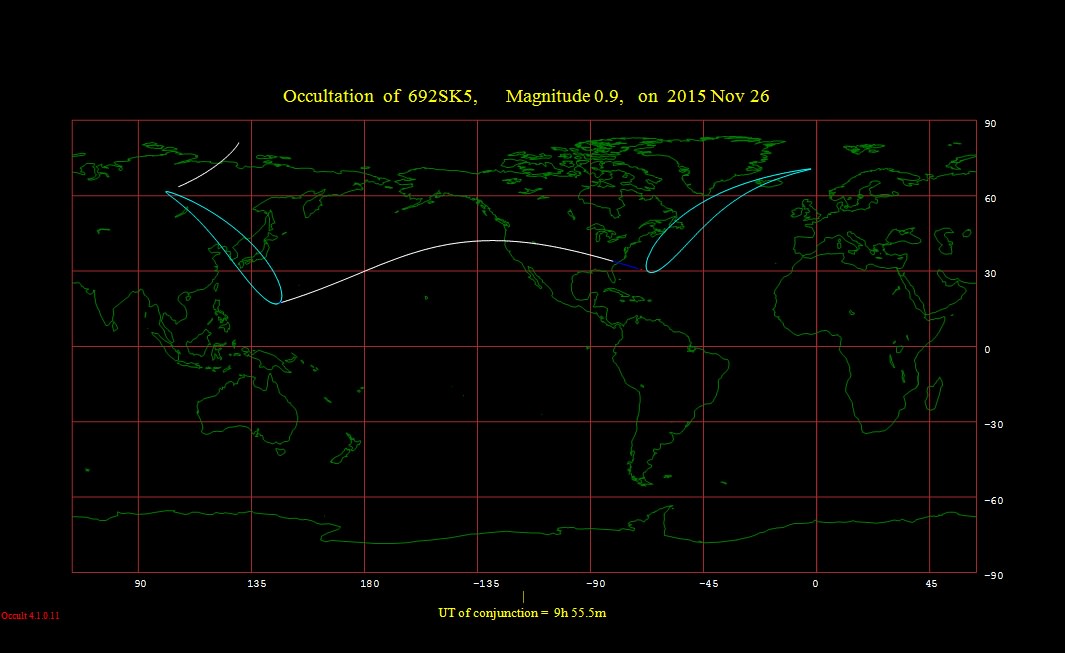
November
01- Io and Ganymede both cast shadows on Jupiter from 17:36 to 17:47 UT.
02- Venus passes 0.7 degrees south of Mars at 00:30 UT.
12- Will the 7 year “Taurid fireball meteor shower” produce?
18- The Leonid meteor shower peaks at 04:00 UT, with an estimated ZHR of 15 favoring Europe.
22- Are we in for a once per decade Alpha Monocerotids outburst? The 2015 peak arrives at 4:25 UT, favoring Europe… with a max ZHR = 400+ possible.
26- The Moon occults Aldebaran for North America at ~9:56 UT.
29- Comet C/2013 X1 PanSTARRS may reach binocular visibility.
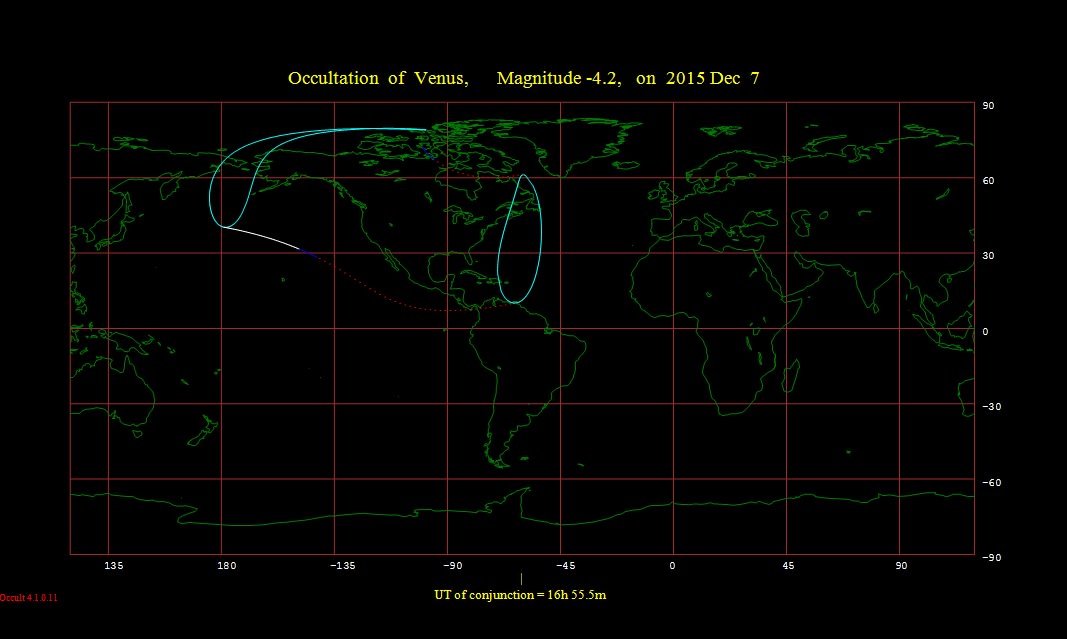
December
01- The International Space Station reaches full illumination as the December solstice nears, resulting in multiple nightly passes favoring the southern hemisphere.
04- Mercury occults the +3.3 magnitude star Theta Ophiuchi for South Africa at 16:16 UT prior to dusk.
06- The Moon occults Mars for central Africa at ~2:42 UT.
07- The Moon occults Venus in the daytime for North America at ~16:55 UT.
14- The Geminid meteor shower peaks at 18:00 UT, with a ZHR=120 favoring NE Asia.
22- The December southward solstice occurs at 4:48 UT.
23- The Ursid meteor shower peaks at 2:30 UT with a ZHR variable from 10-50 favoring Europe and the Middle East.
23- The Moon occults Aldebaran for Europe and central Asia at ~19:32 UT.
29- Mercury reaches greatest evening elongation at 19.7 degrees east of the Sun at 00:01 UT.
Didn’t see your favorite event on the list? Let us know, and be sure to send in any images of these fine events to Universe Today’s Flickr forum.
Enjoy another exciting year of space and astronomy… we’ll be expounding on these events and more as 2015 unfolds.
Sources:
-Kevin McGill’s outstanding astronomical simulations.
-Greatest Elongations of Mercury and Venus.
-Steve Preston’s asteroid occultation predictions for 2015.
-The USNO forecast of phenomena for 2015.
-Seiichi Yoshida’s Weekly Information About Bright Comets.
-Fred Espenak’s NASA Eclipse web page.
-The American Meteor Society’s 2015 predictions.
-The International Meteor Organization’s 2015 page.
-Fourmilab’s lunar perigee and apogee calculator.
The Hunt for KBOs for New Horizons’ Post-Pluto Encounter Continues
Are you ready for the summer of 2015? A showdown of epic proportions is in the making, as NASA’s New Horizons spacecraft is set to pass within 12,500 kilometres of Pluto — roughly a third of the distance of the ring of geosynchronous satellites orbiting the Earth — a little over a year from now on July 14th, 2015.
But another question is already being raised, one that’s assuming center stage even before we explore Pluto and its retinue of moons: will New Horizons have another target available to study for its post-Pluto encounter out in the Kuiper Belt? Researchers say time is of the essence to find it.
To be sure, it’s a big solar system out there, and it’s not that researchers haven’t been looking. New Horizons was launched from Cape Canaveral Air Force Station on January 19th, 2006 atop an Atlas V rocket flying in a 551 configuration in one of the fastest departures from Earth ever: it took New Horizons just nine hours to pass Earth’s moon after launch.
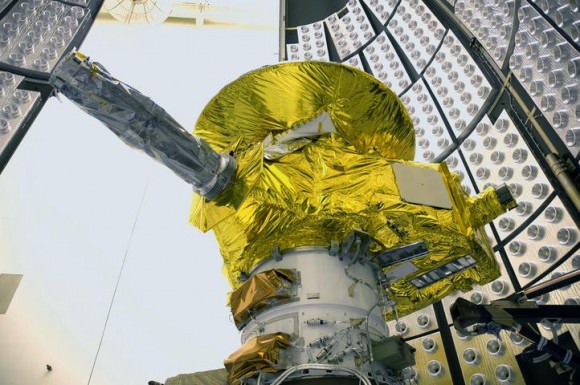
The idea has always been out there to send New Horizons onward to explore and object beyond Pluto in the Kuiper Belt, but thus far, searches for a potential target have turned up naught.
A recent joint statement from NASA’s Small Bodies and Outer Planets Assessment Groups (SBAG and OPAG) has emphasized the scientific priority needed for identifying a possible Kuiper Belt Object (KBO) for the New Horizons mission post-Pluto encounter. The assessment notes that such a chance to check out a KBO up close may only come once in our lifetimes: even though it’s currently moving at a heliocentric velocity of just under 15 kilometres a second, it will have taken New Horizons almost a decade to traverse the 32 A.U. distance to Pluto.
The report also highlights the fact that KBOs are expected to dynamically different from Pluto as well and worthy of study. The statement also notes that the window may be closing to find such a favorable target after 2014, as the upcoming observational apparition of Pluto as seen from Earth — and the direction New Horizons is headed afterwards — reaches opposition this summer on July 4th.
But time is of the essence, as it will allow researchers to plan for a burn and trajectory change for New Horizons shortly after its encounter with Pluto and Charon using what little fuel it has left. Then there’s the issue of debris in the Pluto system that may require fine-tuning its trajectory pre-encounter as well. New Horizons will begin long range operations later this year in November, switching on permanently for two years of operations pre-, during and post- encounter with Pluto.
And there currently isn’t a short-list of “next best thing” targets for New Horizons post-Pluto encounter. One object, dubbed VNH0004, may be available for distant observations in January of next year, but even this object will only pass 75 million kilometres — about 0.5 A.U. — from New Horizons at its closest.
Ground based assets such as the Keck, Subaru and Gemini observatories have been repeatedly employed in the search over the past three years. The best hopes lie with the Hubble Space Telescope, which can go deeper and spy fainter targets.
Nor could New Horizons carry out a search for new targets on its own. Its eight inch (20 cm in diameter) LORRI instrument has a limiting magnitude of about +18, which is not even close to what would be required for such a discovery.
New Horizons currently has 130 metres/sec of hydrazine fuel available to send it onwards to a possible KBO encounter, limiting its range and maneuverability into a narrow cone straight ahead of the spacecraft. This restricts the parameters for a potential encounter to 0.35 A.U. off of its nominal path for a target candidate be to still be viable objective. New Horizons will exit the Kuiper Belt at around 55 A.U. from the Sun, and will probably end its days joining the Voyager missions probing the outer solar system environment. Like Pioneers 10 and 11, Voyagers 1 and 2 and the upper stage boosters that deployed them, New Horizons will escape our solar system and orbit the Milky Way galaxy for millions of years. We recently proposed a fun thought experiment concerning just how much extraterrestrial “space junk” might be out there, littering the galactic disk.
And while the crowd-sourced Ice Hunters project generated lots of public engagement, a suitable target wasn’t found. There is talk of a follow up Ice Investigators project, though it’s still in the pending stages.
Another issue compounding the problem is the fact that Pluto is currently crossing the star rich region of the Milky Way in the constellation Sagittarius. Telescopes looking in this direction must contend with the thousands of background stars nestled towards the galactic center, making the detection of a faint moving KBO difficult. Still, if any telescope is up to the task, it’s Hubble, which just entered its 25th year of operations last month.
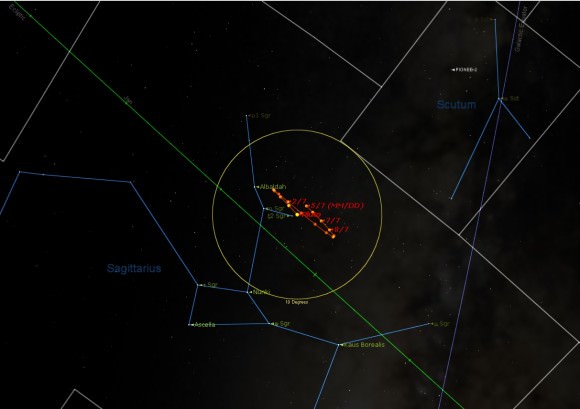
Shining at +14th magnitude, Pluto will be very near the 3.5th magnitude star Xi2 Sagittarii during the July 2015 encounter.
New Horizons is currently 1.5 degrees from Pluto — about 3 times the angular size of a Full Moon —as seen from our Earthly vantage point, and although neither can be seen with the naked eye, you can wave in their general direction this month on May 18th, using the nearby daytime Moon as a guide.
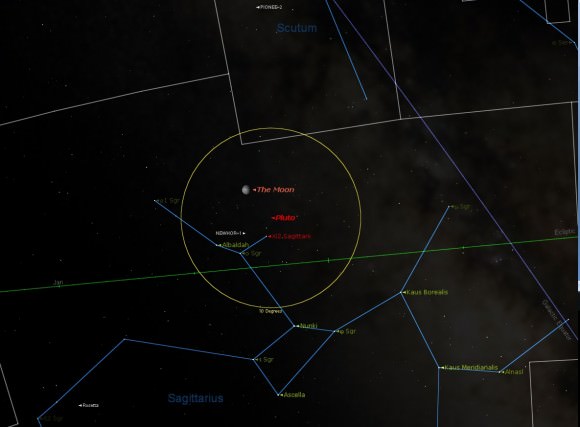
July 2015 will be an exciting and historic time in solar system exploration. Does Pluto have more undiscovered moons? A ring system of its own? Does it resemble Neptune’s moon Triton, or will it turn out looking entirely different ?
If nothing else, exploration of Pluto will finally give us science writers some new images to illustrate articles on the distant world, rather than recycling the half a dozen-odd photos and artist’s conceptions that are currently available. An abundance of surface features will then require naming as well. It would be great to see Pluto’s discoverer Clyde Tombaugh and Venetia Burney — the girl who named Pluto — get their due. We’ll even assume our space pundit’s hat and predict a resurgence of the “is it a planet?” debate once again in the coming year as the encounter nears…
Onward to Pluto and the brave new worlds beyond!

